Overview
This documentation covers the comprehensive knowledge management system for AI agents, including indexing strategies, PII masking, and enrichment capabilities. The system uses a four-stage pipeline to process and optimize knowledge for retrieval.
Knowledge Indexing Pipeline
When you add a knowledge document to your AI agent, it goes through a four-step pipeline:
Parsing– Making Sense of Your DocumentThe parsing phase transforms diverse document types (e.g., PDFs, DOCX, PPTX) into machine-readable formats.
Supported Extracted Elements:Text: Raw readable content
Images: Visual data (charts, infographics)
Tables: Structured row-column formats
Layout & Formatting: Hierarchy, headings, bullets, etc.
Tip
Good formatting (like proper headings and lists) significantly boosts parsing accuracy.
Chunking– Breaking Documents Into Bite-Sized PiecesAfter parsing, the next step is chunking—which simply means splitting a big document into smaller parts.
Why is this important?Faster Responses: Instead of scanning the whole document, the AI can quickly look through just the pieces (chunks) that matter.
Less Strain on Memory: Smaller pieces are easier for the system to process, which makes everything run more smoothly.
Better Accuracy: By focusing only on the most relevant chunks, the AI is more likely to give precise and accurate answers.
Embedding– Turning Text into Meaningful MathOnce your document is broken into chunks, the next step is to turn each chunk into a number-based format called an embedding.
Here’s what that means:Each chunk becomes a vector: A vector is just a set of numbers that represents the meaning of the text.
Similar meanings = closer vectors For example, "great" and "awesome" might be far apart in a sentence, but their vectors will be close together because they mean similar things.
Queries become vectors too: When you ask a question, the system turns your query into a vector and looks for document chunks with similar vectors.
It finds the closest matches: This is how the AI figures out which parts of the document best answer your question.
In short, embedding lets the AI find meaning and relevance using math—even if the exact words don’t match.
Indexing– Organizing for Fast SearchAfter the document chunks are turned into vectors, the next step is to store them in a smart, searchable way. That’s what indexing does.
Here’s how it works:All vectors go into a special database: This database is built to quickly find and compare these number-based vector representations.
Fast lookups: When you ask a question, the system can quickly scan the database to find the most relevant chunks.
Optimized for performance: Indexing ensures that even with thousands of documents, the AI can find answers in seconds, not minutes.
In short, indexing organizes all the embedded knowledge so your AI can search and respond lightning-fast.
Knowledge Settings Interface
Once a document is added, you can configure several settings to control how it's parsed, indexed, and used.

Note
Indexing settings will use the global agent configuration by default. You can customize settings here to override global defaults for specific MIME formats. Any changes made here will only apply to this knowledge source.
Indexing Strategies
Each knowledge source allows customization of parsing, indexing, and enrichment parameters. These can override global agent configurations for greater control.
Creating New Indexing Strategies
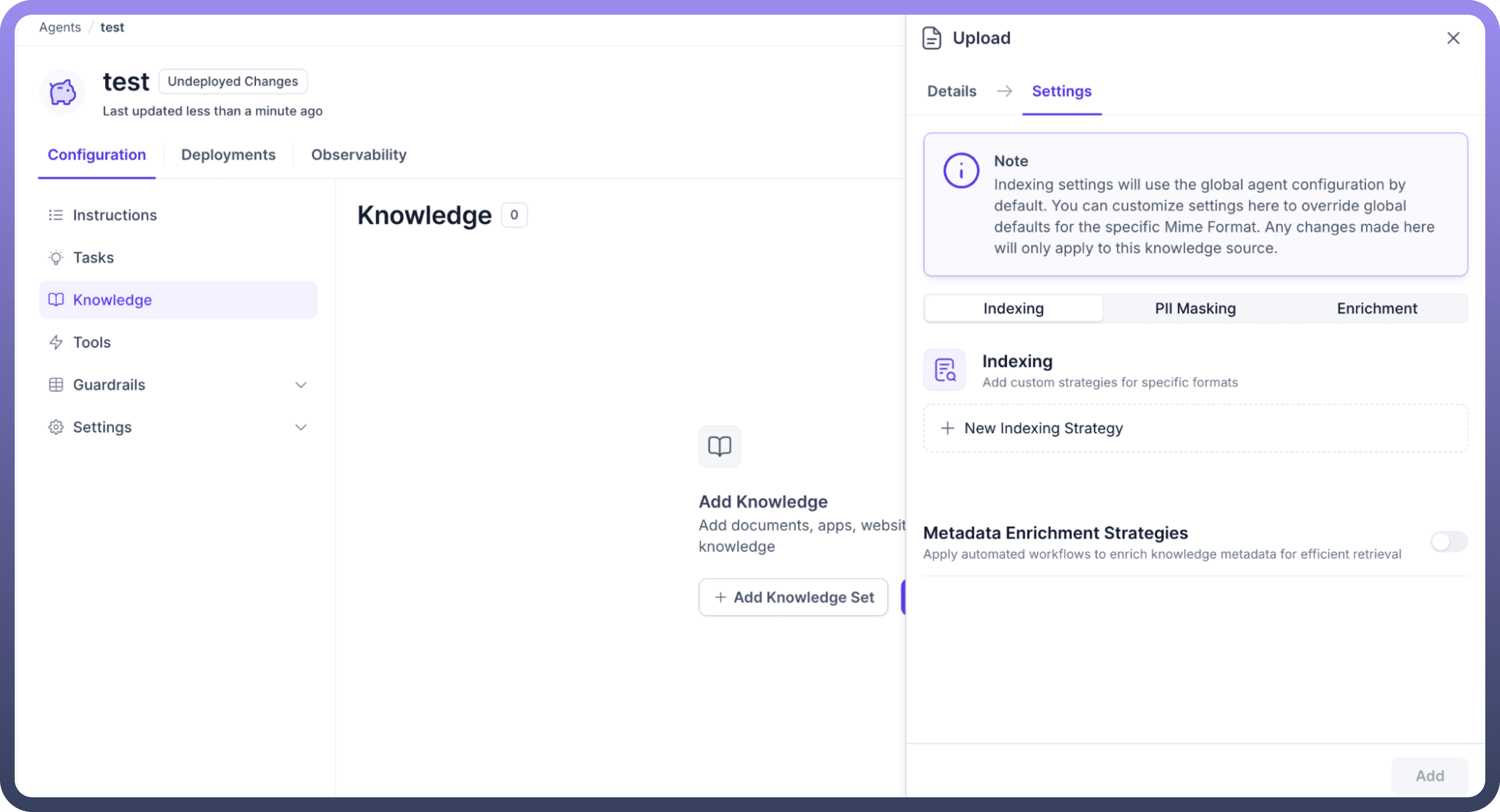
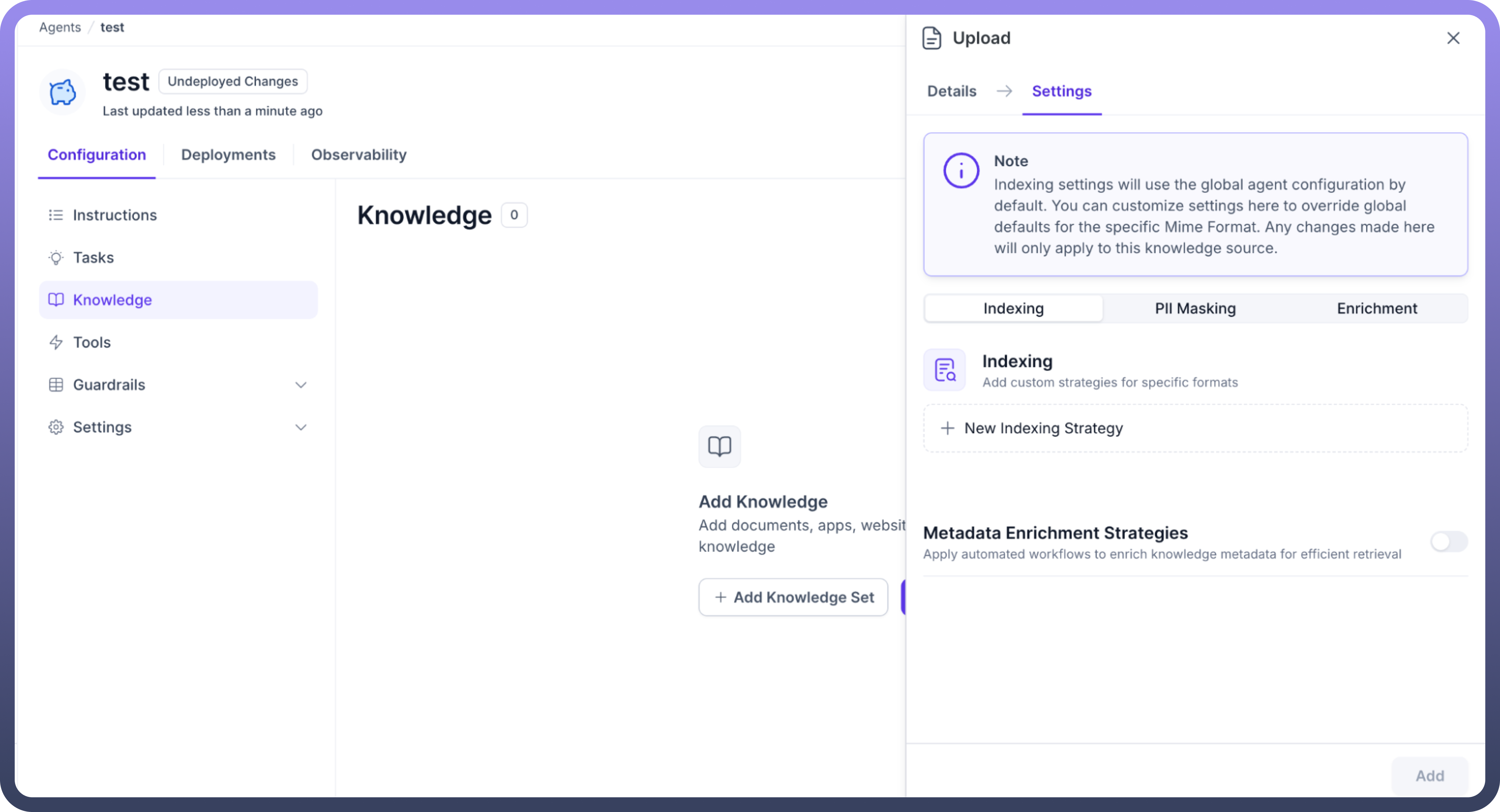
MIME Type Selection
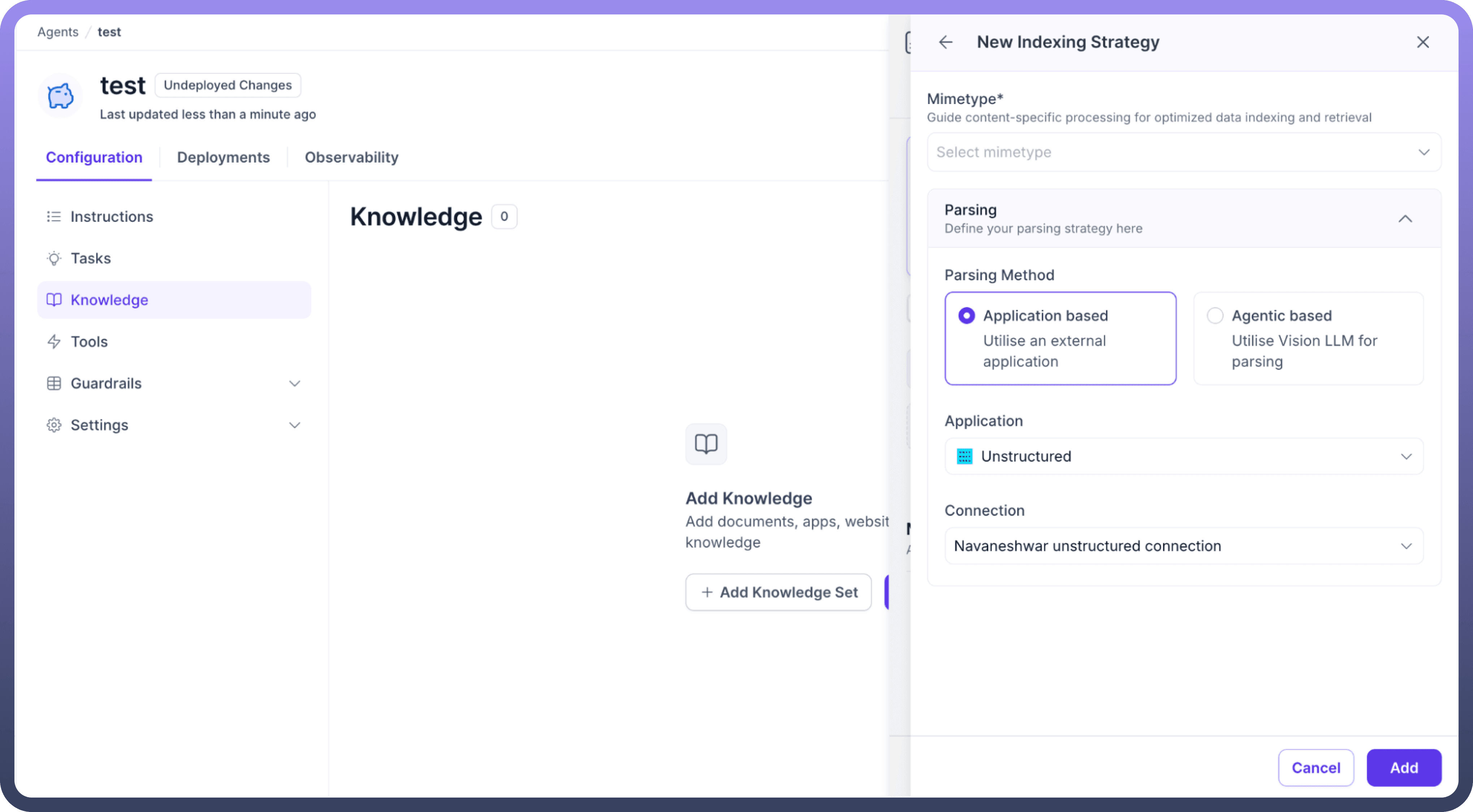
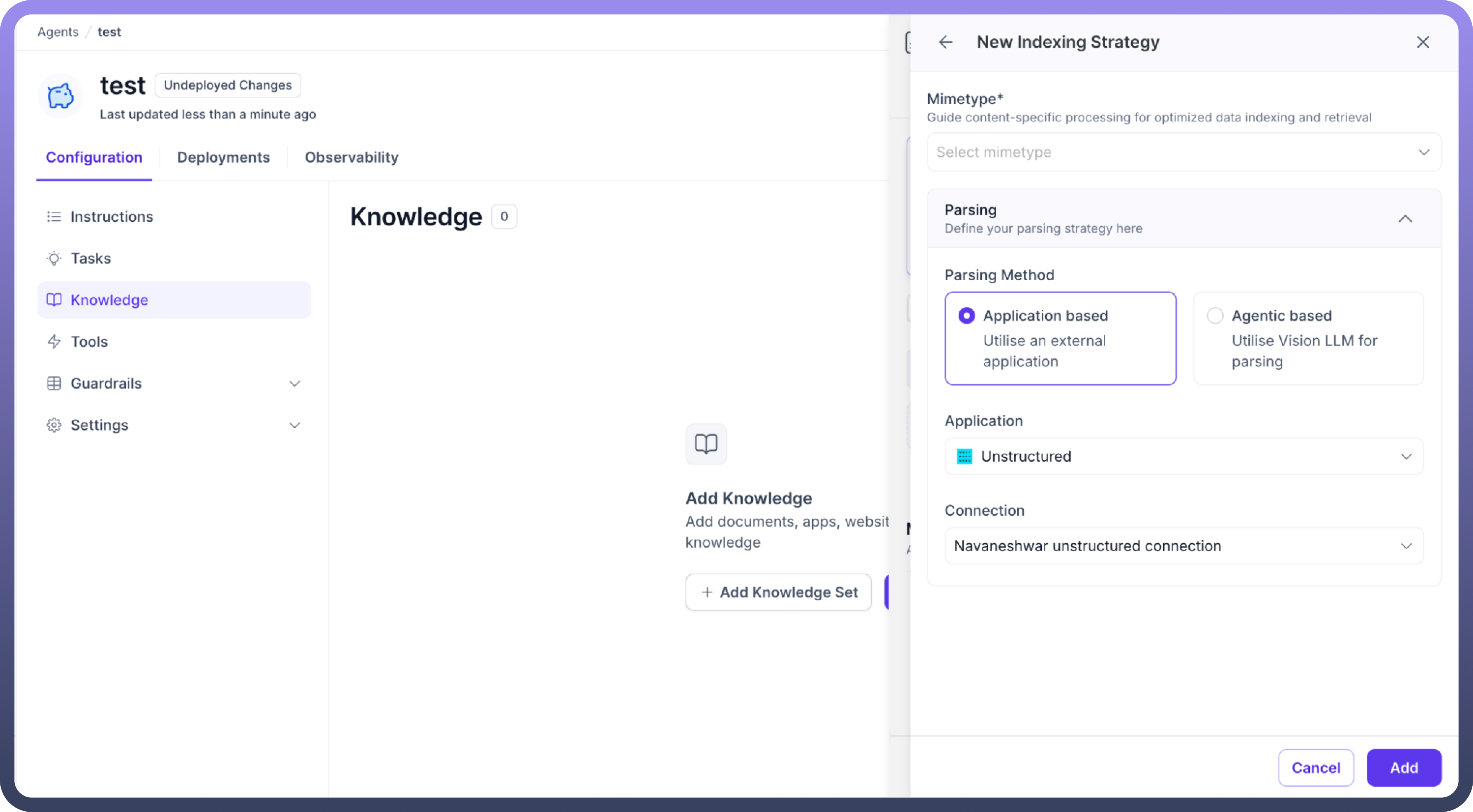
Select the correct format to optimize parsing strategy:
MIME Type | Use Case |
| Tabular datasets, KPIs |
| Reports, SOPs, policies |
| Visual decks, product slides |
| Contracts, scanned docs |
| Developer documentation |
| Structured config/data |
| Scanned docs, charts |
| Batch uploads |
| Simple logs, notes |
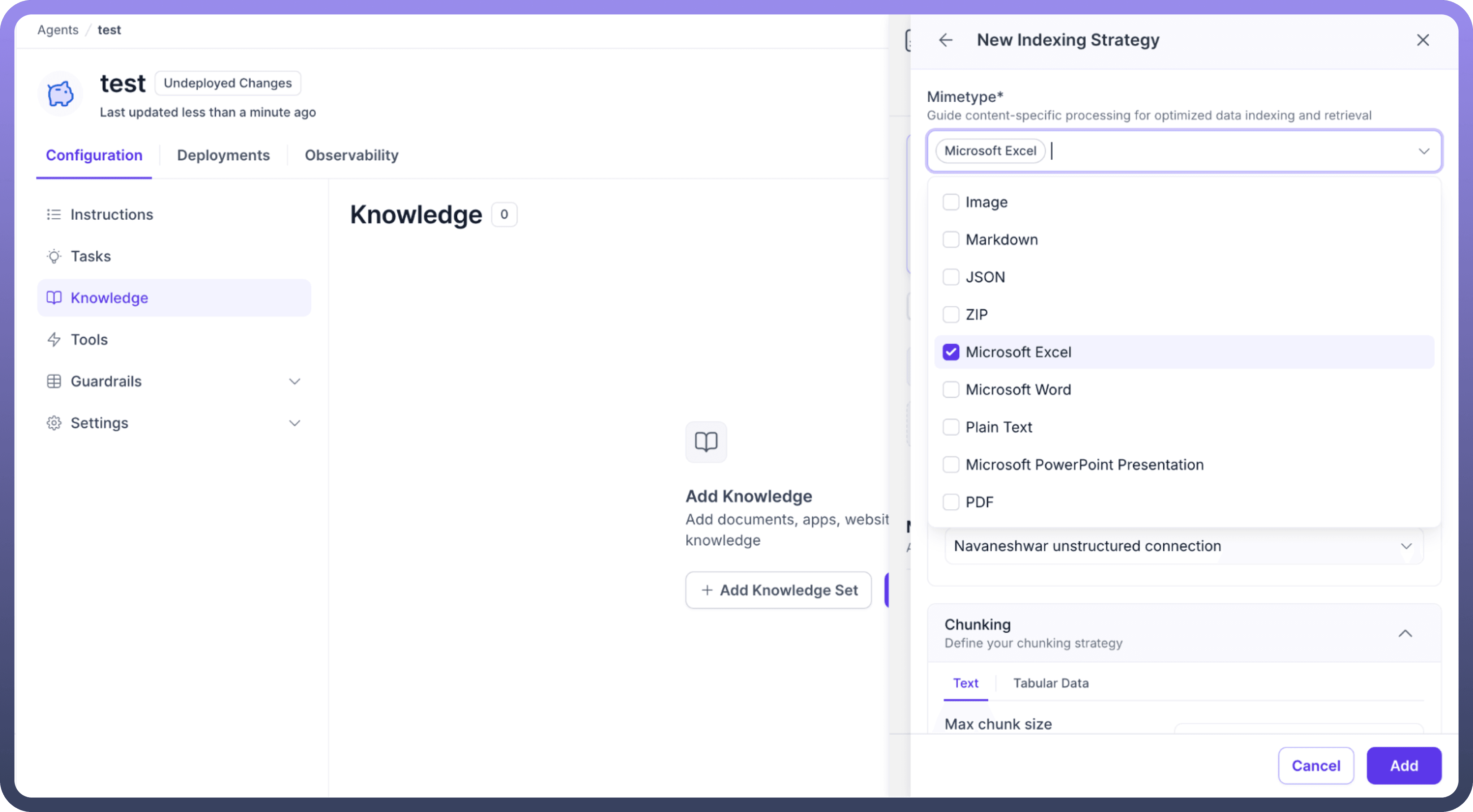
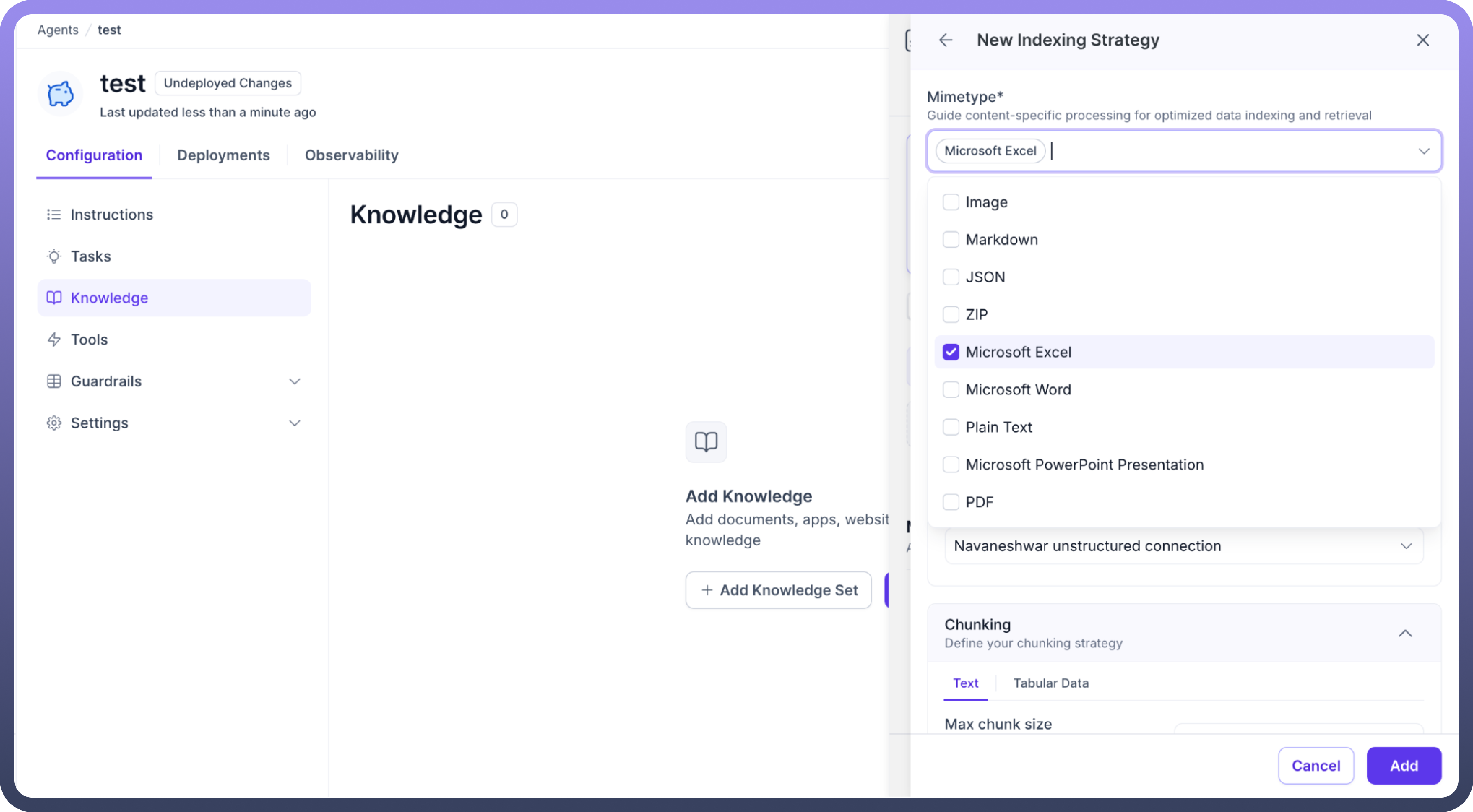
Parsing Methods

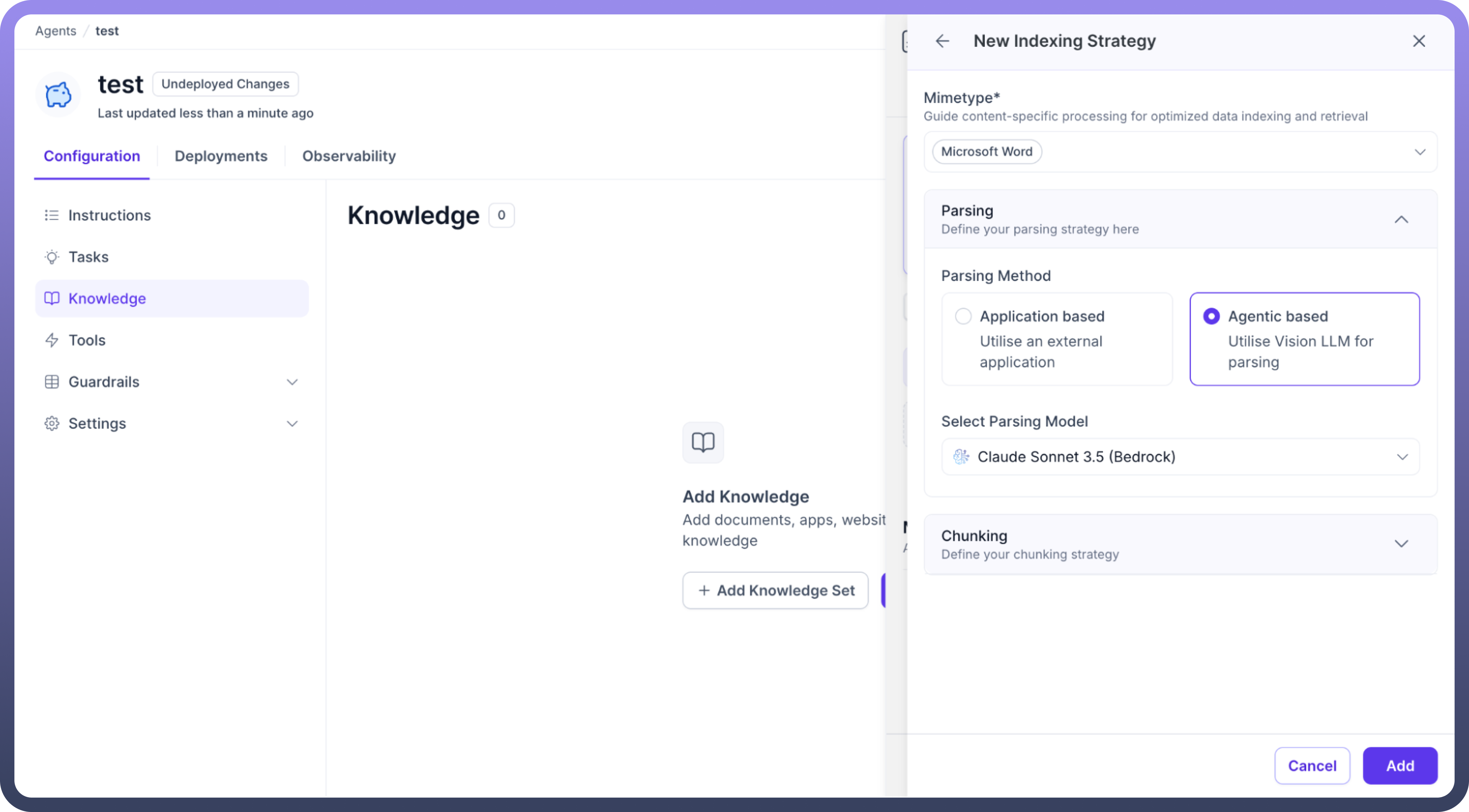
Application-Based ParsingDescription: Utilizes external applications for parsing
Speed: Faster processing
Accuracy: Standard accuracy
Best for: Simple documents with minimal visual complexity
Connection: Requires configured external connections (e.g., "Unstructured connection")
Agentic-Based ParsingDescription: Utilizes Vision LLM for parsing
Speed: Slower processing
Accuracy: Higher accuracy with visual elements
Best for: Complex documents with charts, graphs, images, and visual data
Model Selection: Choose from available models (e.g., Claude Sonnet 3.5 Bedrock)
Recommendation: Use for heavy OCR tasks and vision-related processing
Chunking Strategies
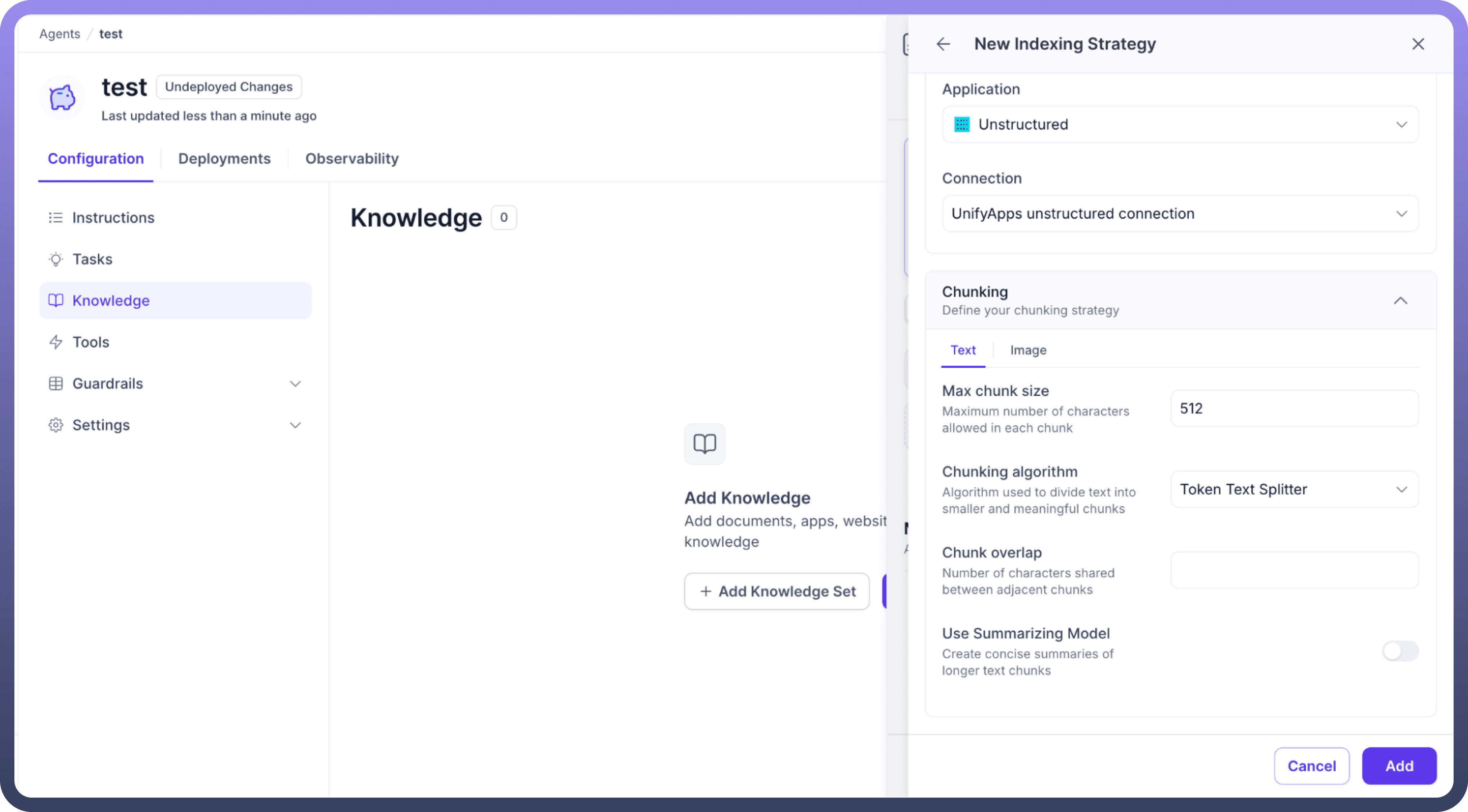
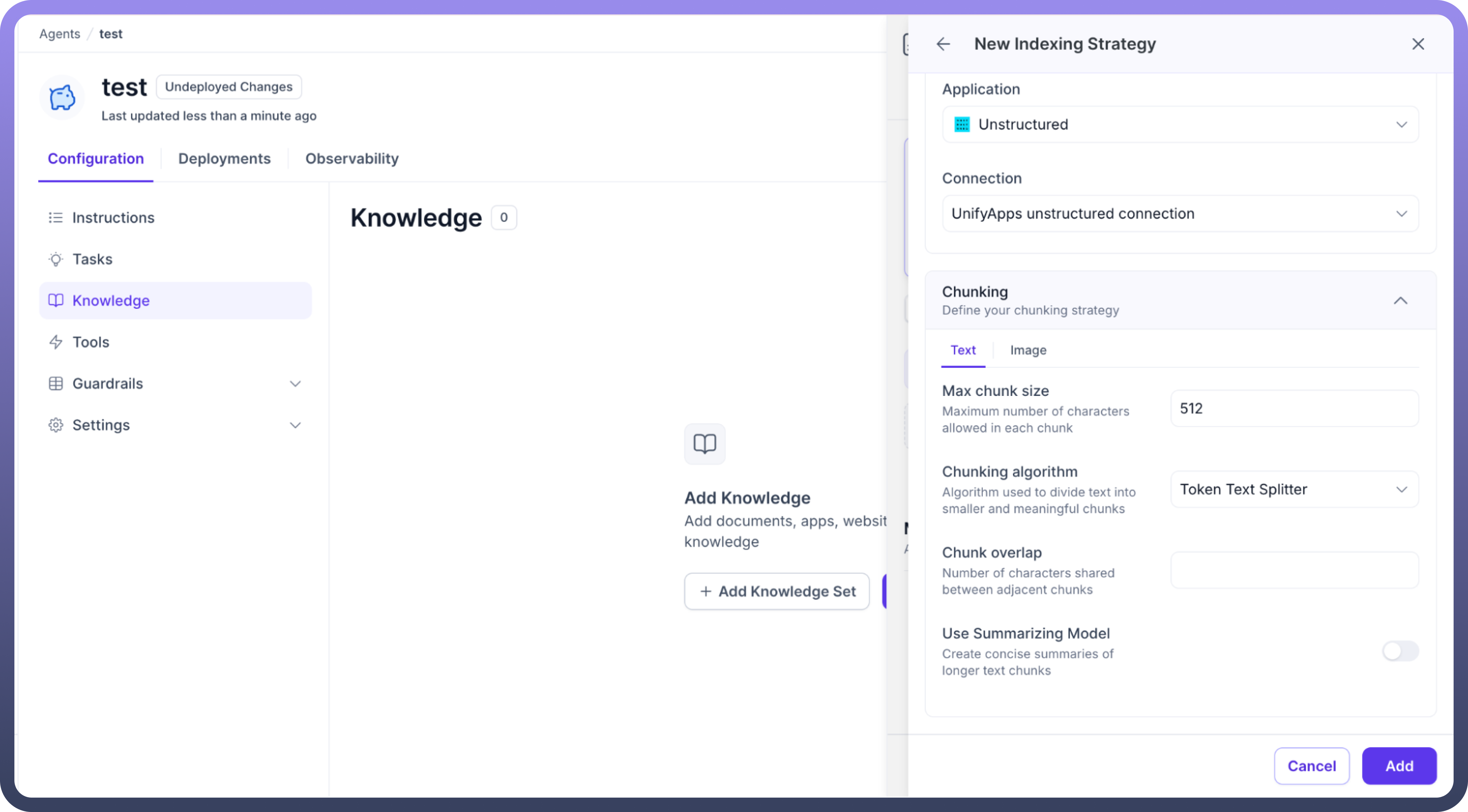
Text Chunking
Max Chunk Size: Configure maximum characters per chunk (default: 512)
Chunking Algorithm: Algorithm used to divide text into smaller and meaningful chunks
Chunk Overlap: Number of characters shared between adjacent chunks
Use Summarizing Model: Creates concise summaries of longer text chunks
Image Chunking
Processing Method: Technique to analyze and extract structured data from images
Image to Text: Converts visual content to text format
Text Extraction Model: Select appropriate model for OCR processing
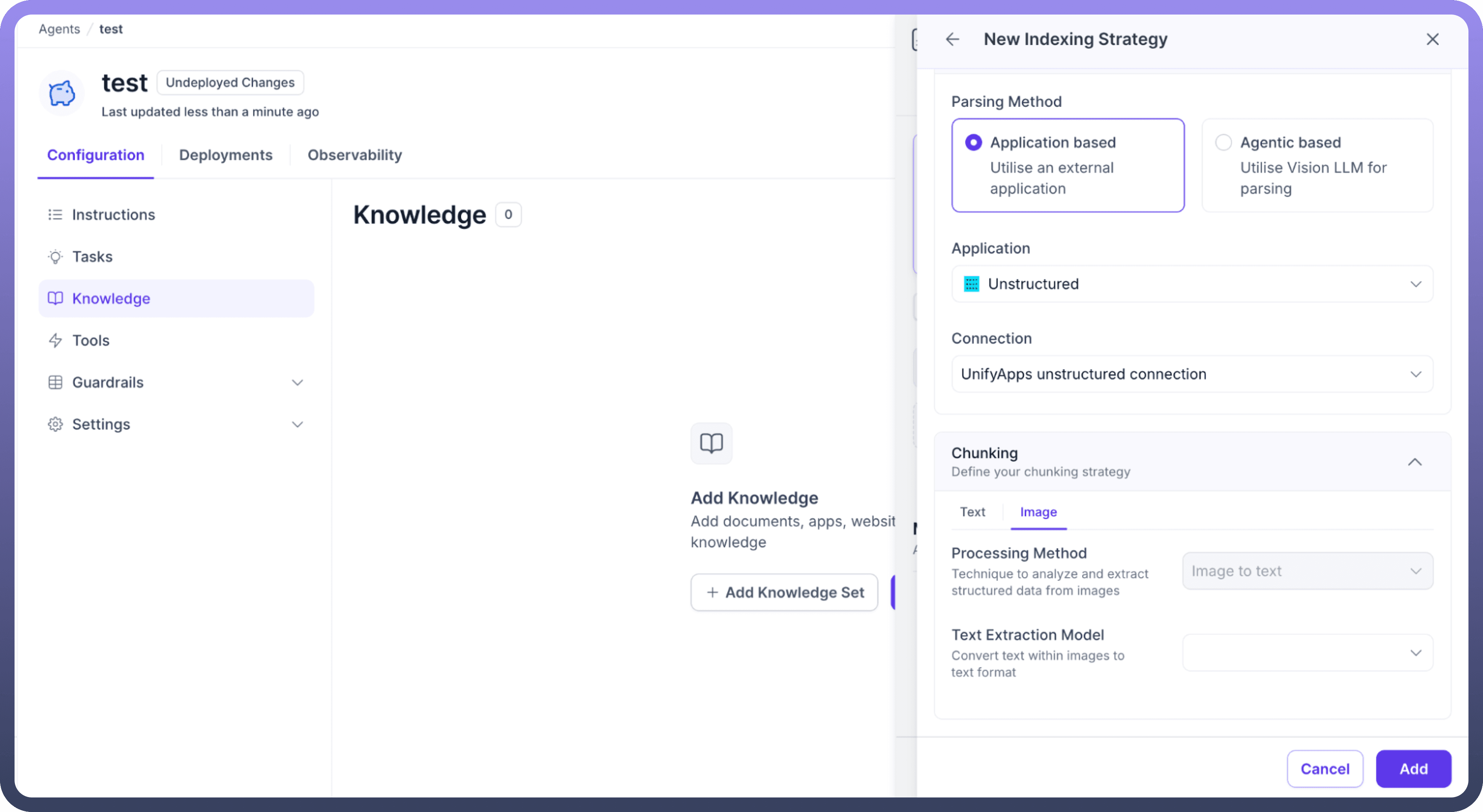
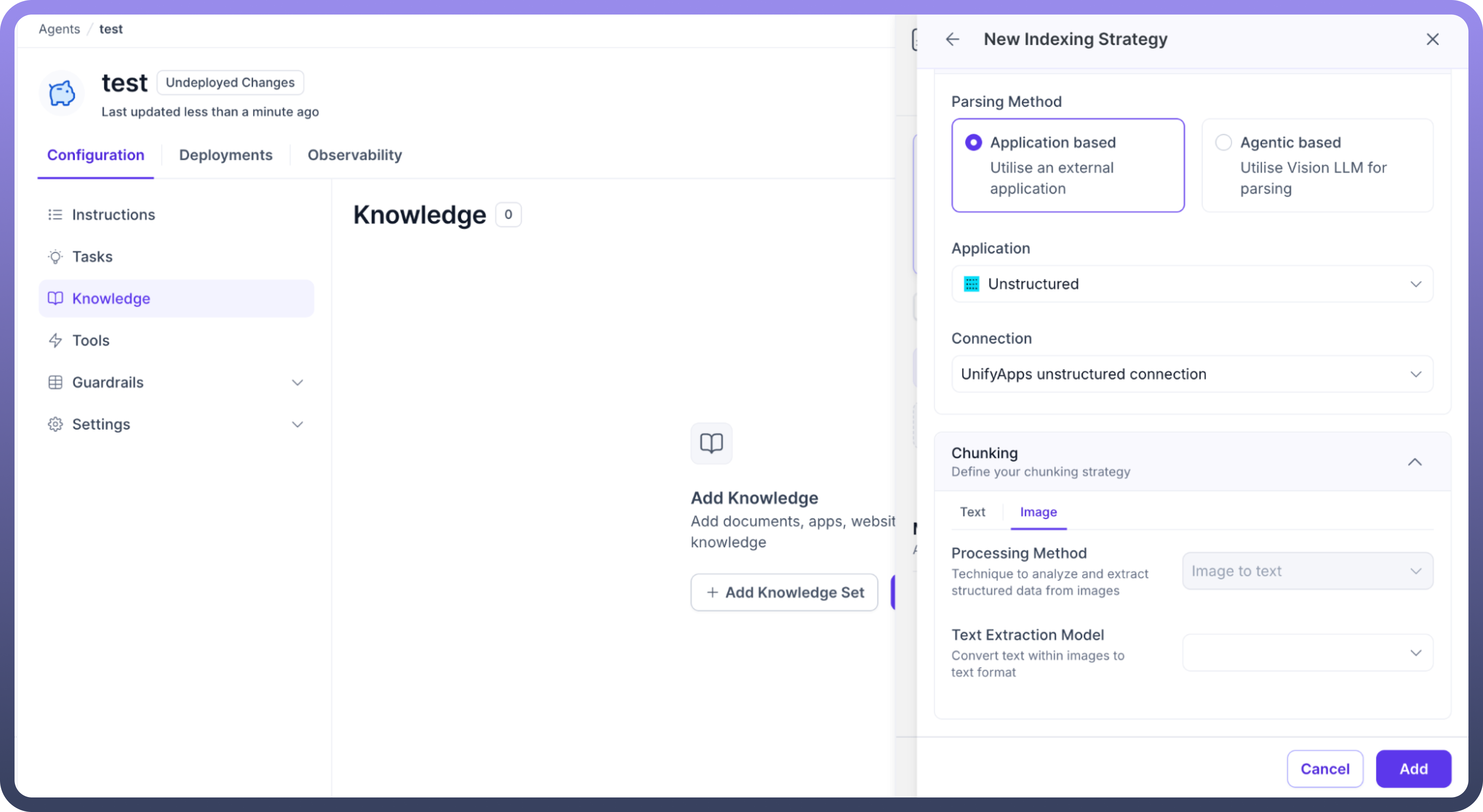
Tabular Data Processing
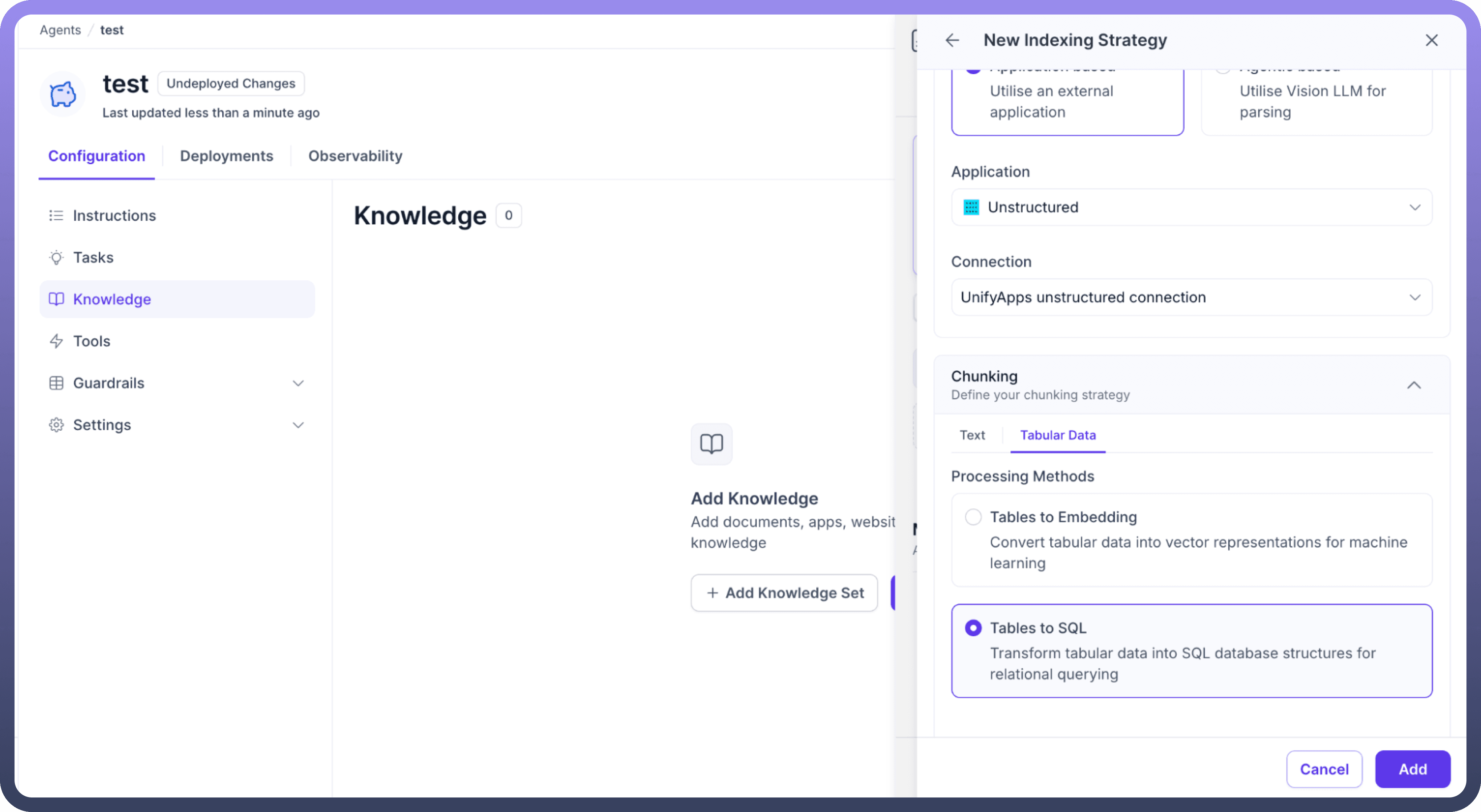
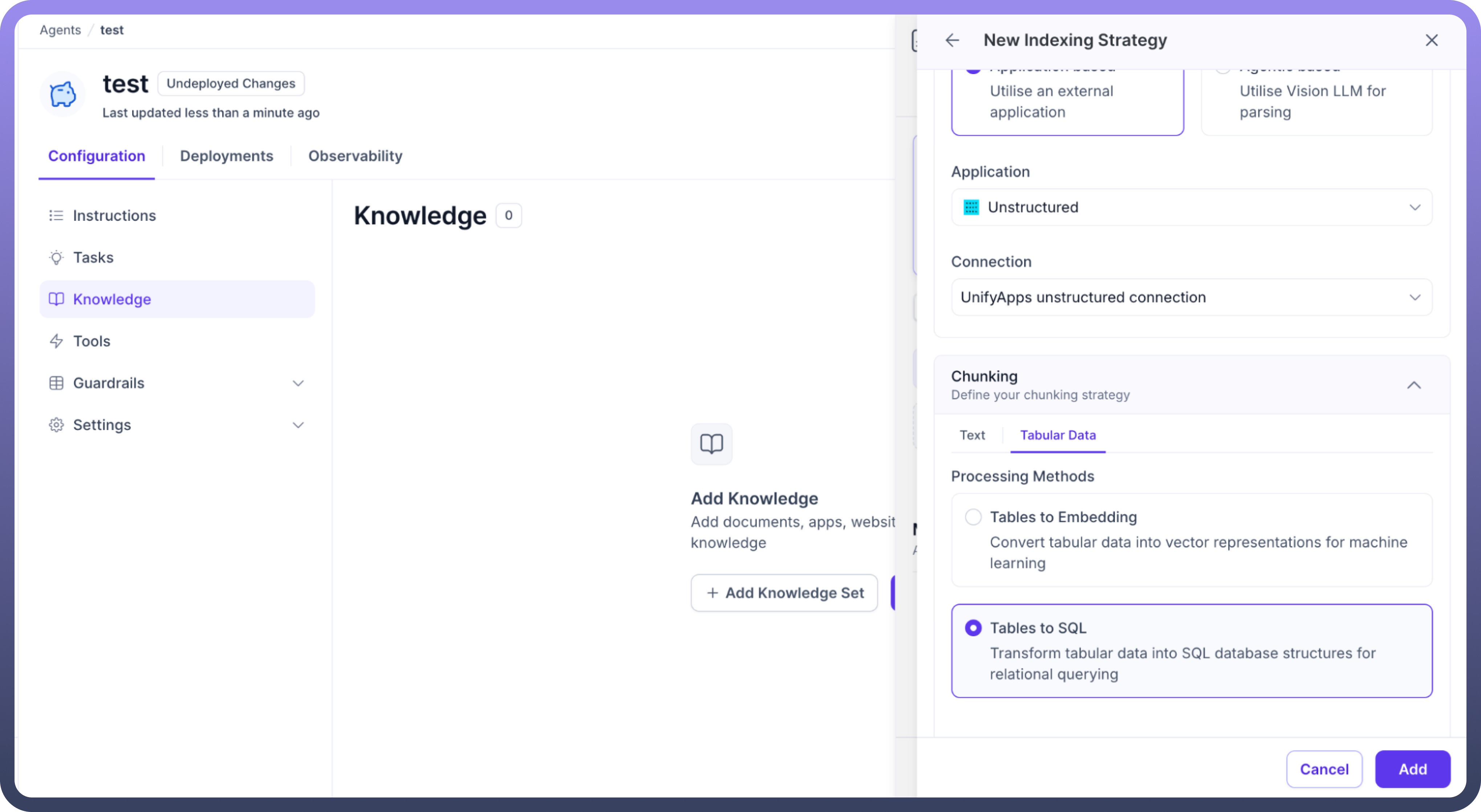
Tables to EmbeddingsPurpose: Convert tabular data into vector representations for machine learning
Use Case: Semantic search across table data
Best for: Exploratory queries and information retrieval.
Tables to SQLPurpose: Transform tabular data into SQL database structures for relational querying
Use Case: Precise data lookups and structured queries
Best for: Exact data retrieval and analytical queries
Requirement: First row must contain column headers
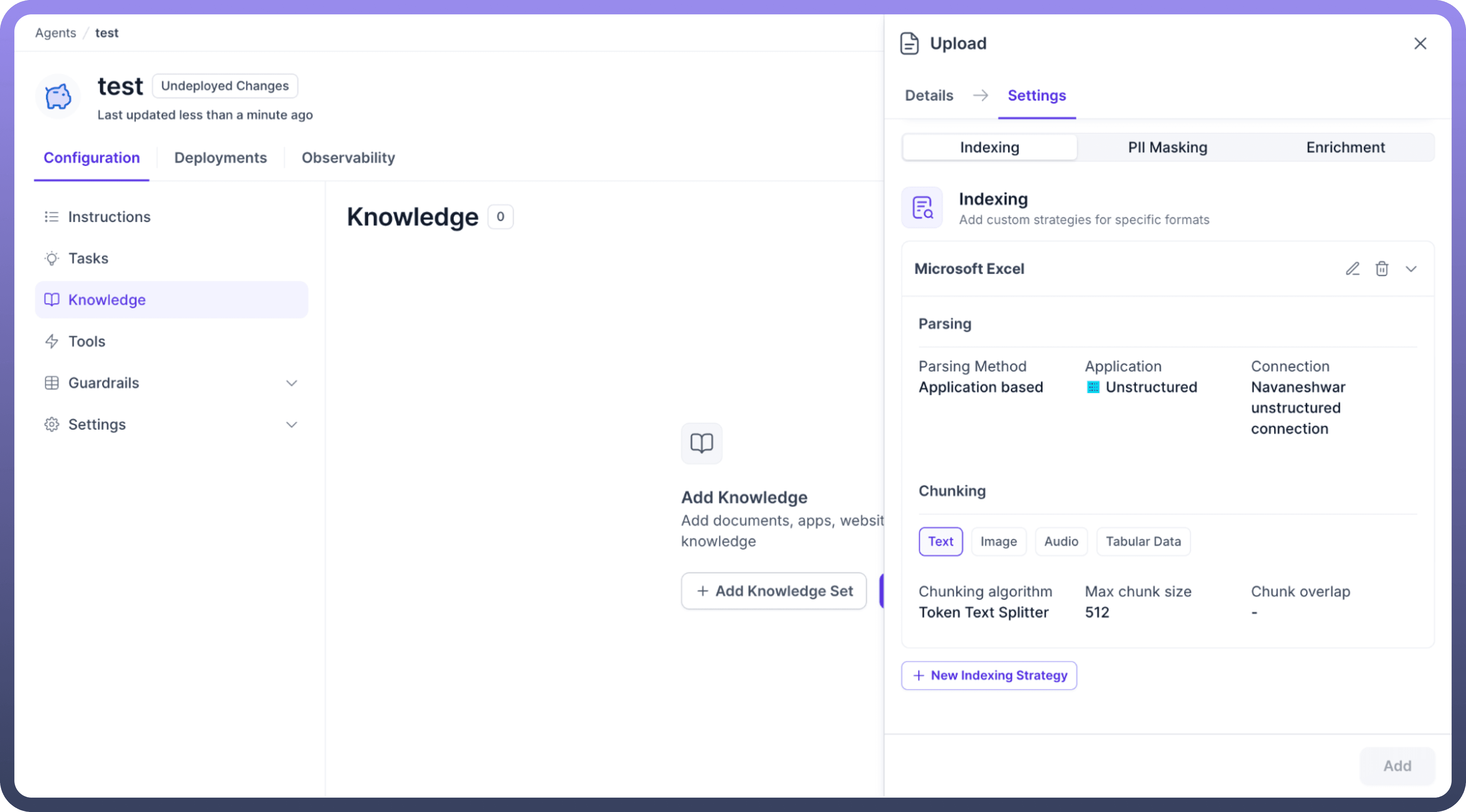
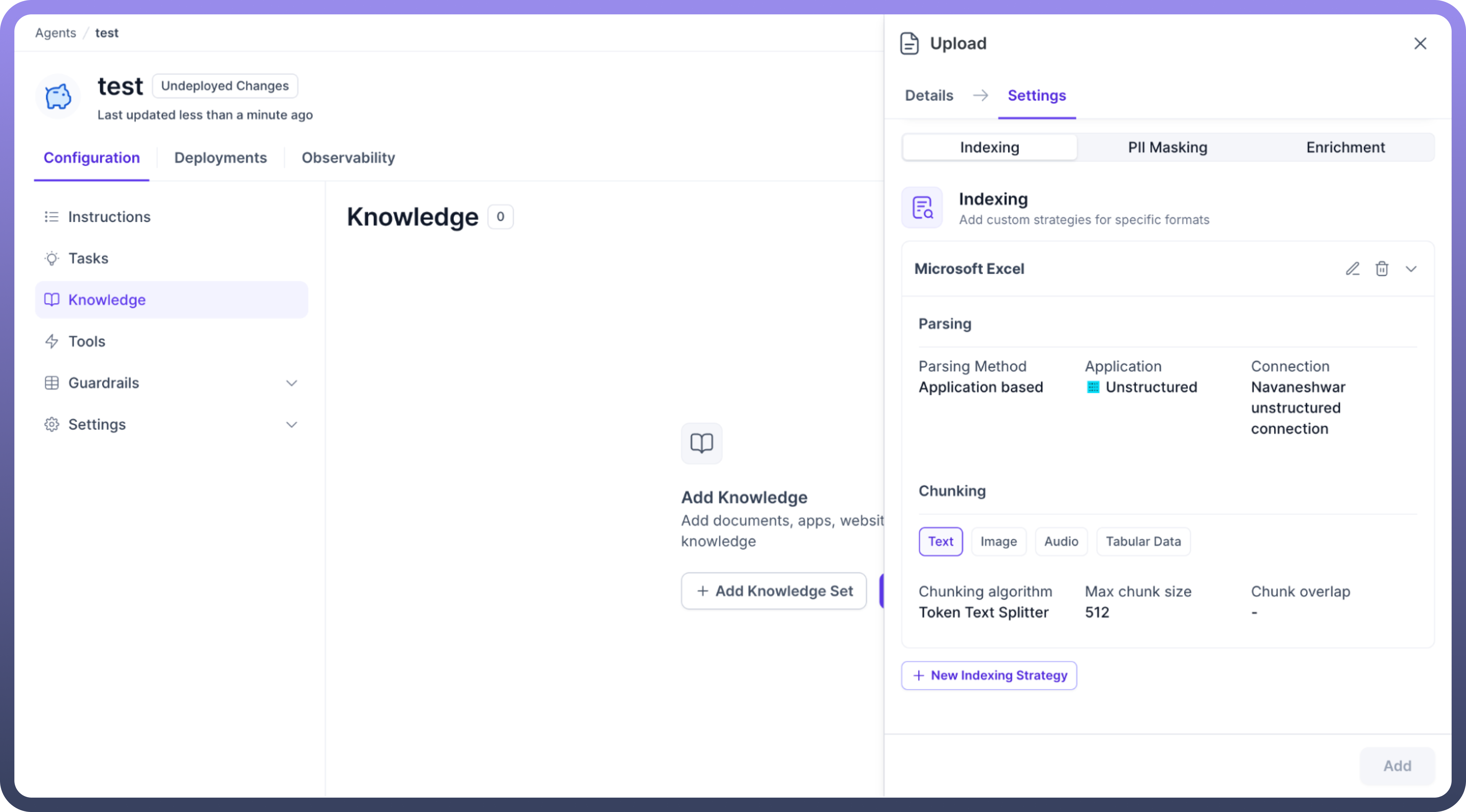
PII Masking
Filter out sensitive information using multiple detection and protection methods to ensure data privacy and compliance.
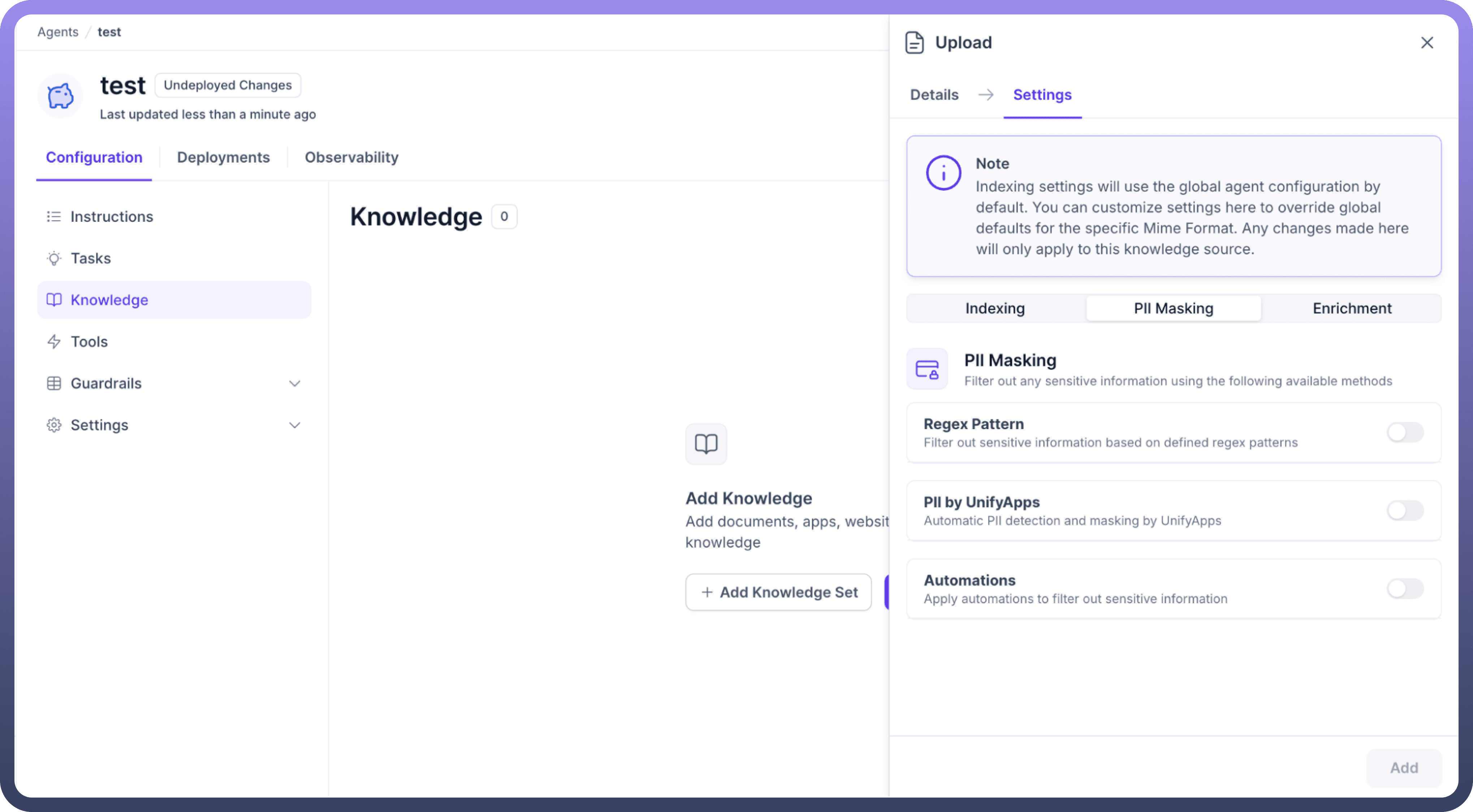
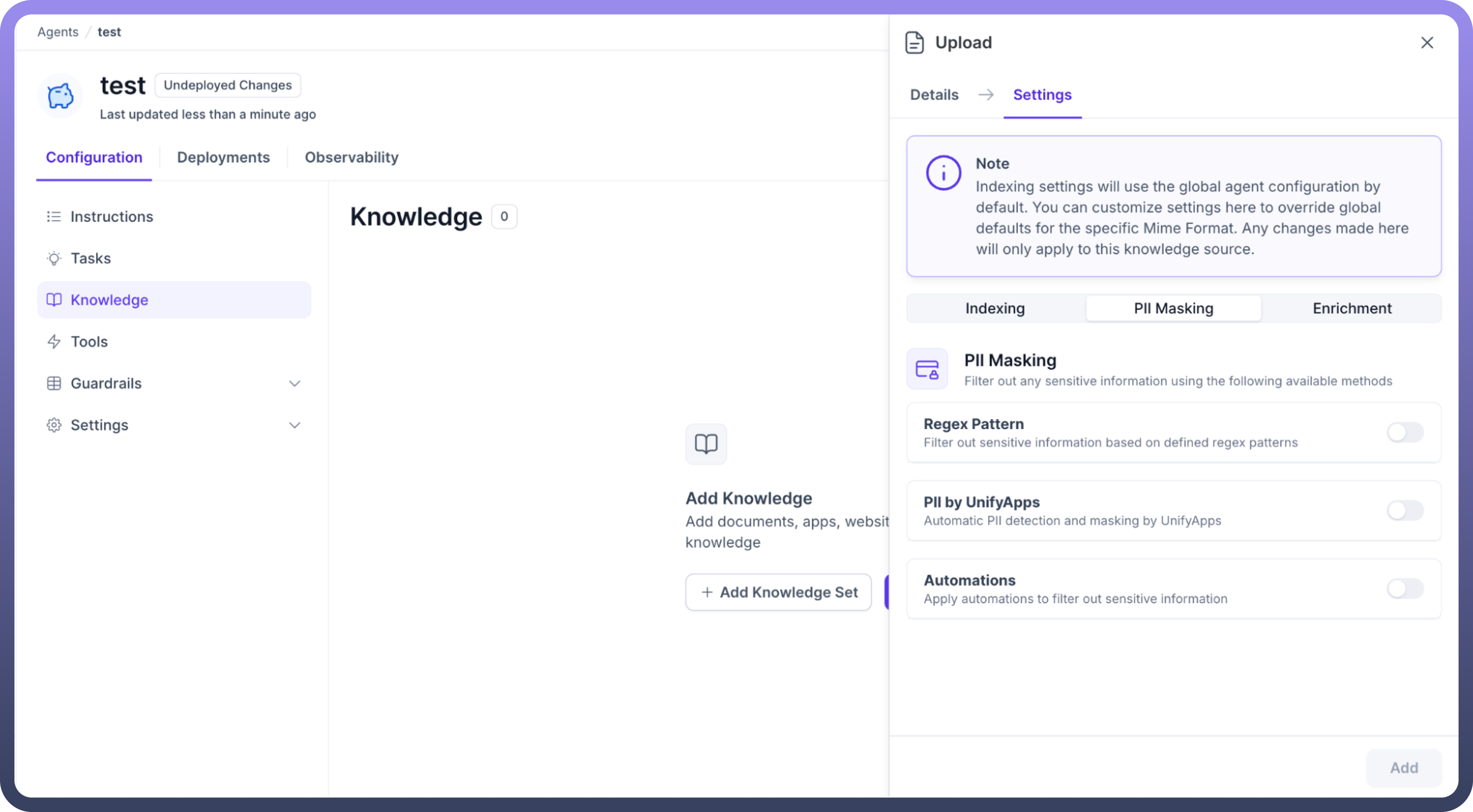
Available Methods
Regex Pattern: Filter out sensitive information based on defined regex patterns
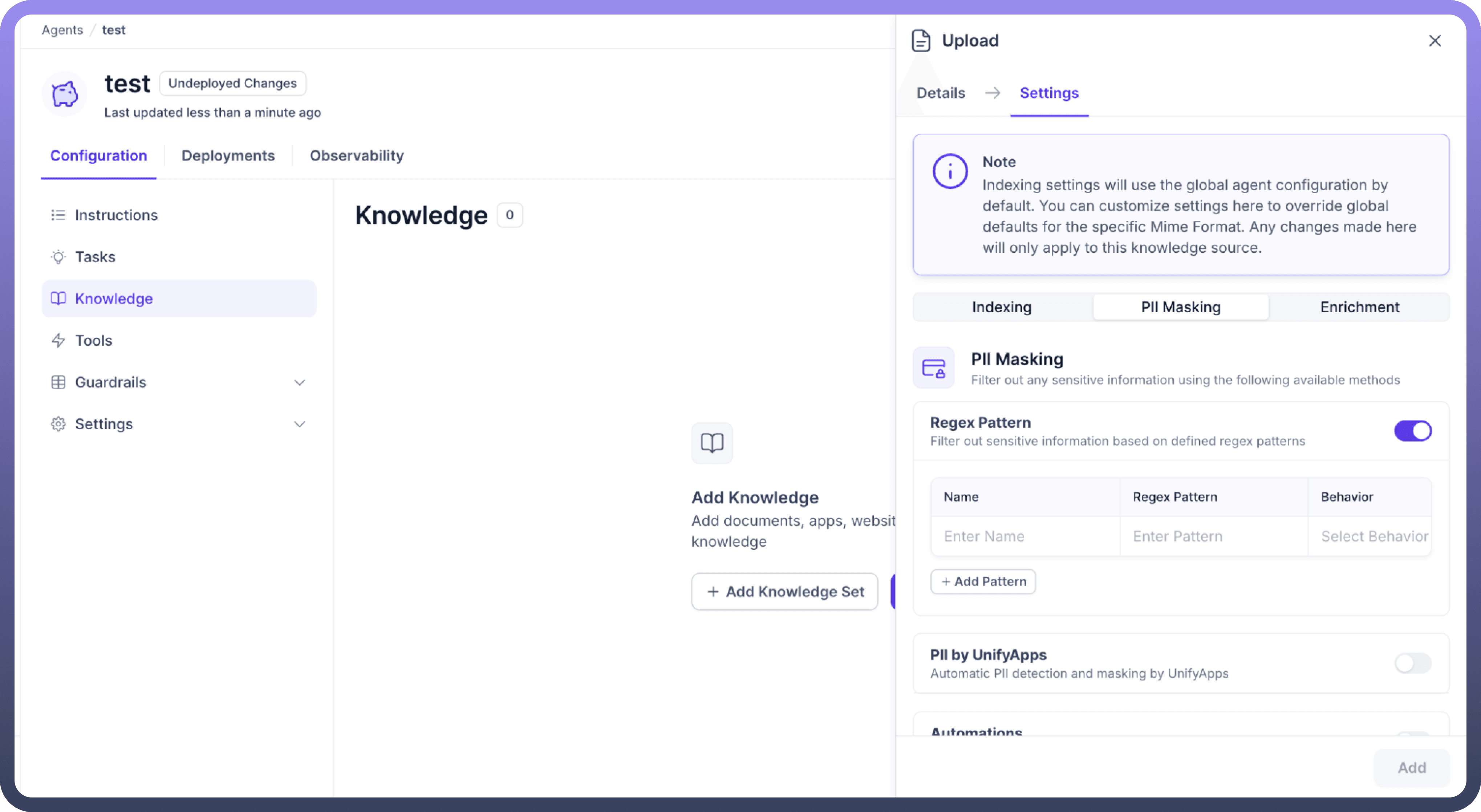
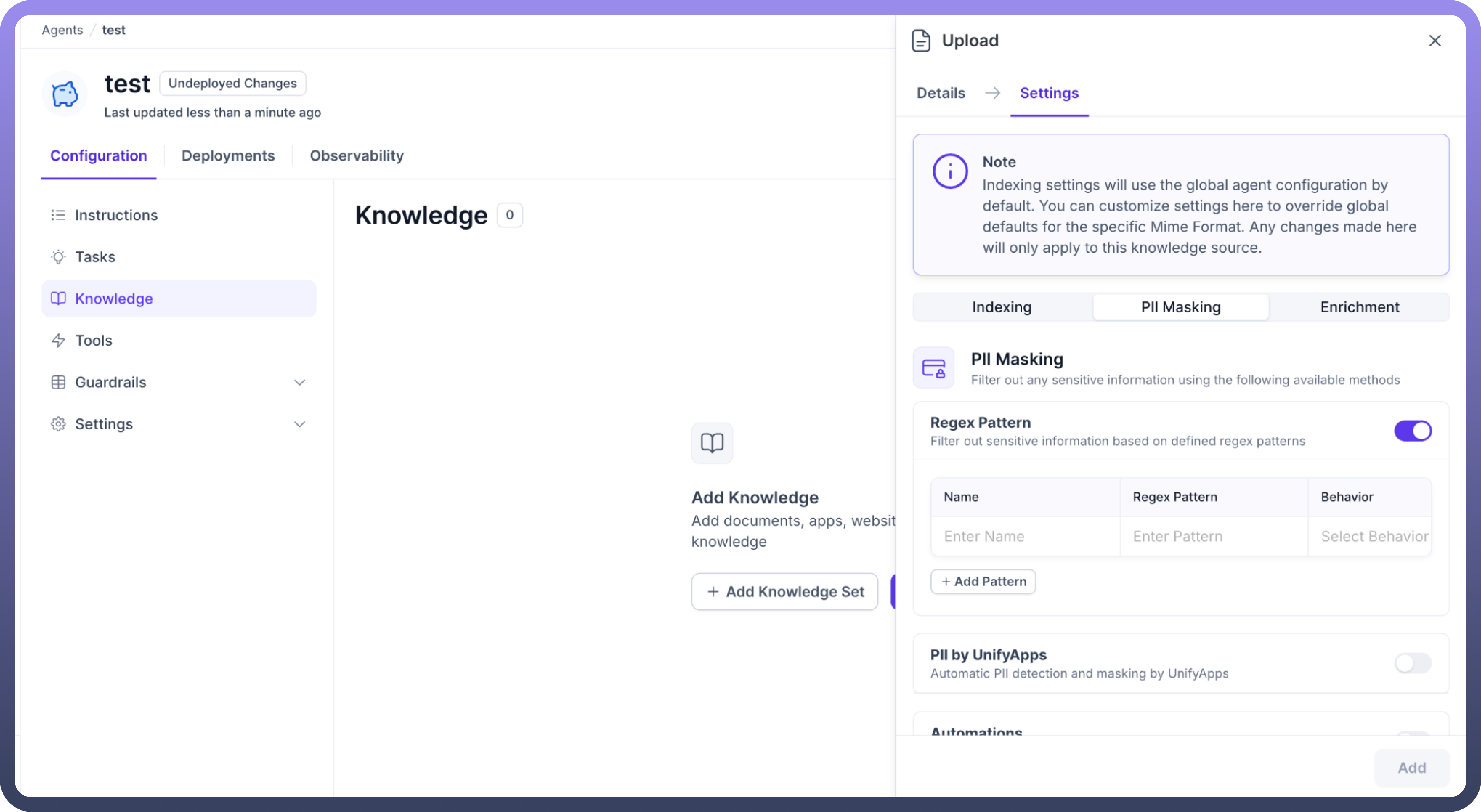
Use Cases:Custom sensitive data formats
Organization-specific identifiers
Industry-specific sensitive patterns
Configuration:Name: Descriptive name for the pattern
Regex Pattern: Define the pattern to match sensitive data
Behavior: Choose action when pattern is detected
Mask: Hide matching content from the agent
Block: Stop processing entirely if pattern is found
PII by UnifyApps : Automatic PII detection and masking by UnifyApps
Features:
Automatically detects common PII types:
Credit card numbers
Social security numbers
Phone numbers
Email addresses
Personal identifiers
No manual configuration required
Built-in intelligence for common sensitive data patterns
Automations: Apply custom automations to filter out sensitive information
Capabilities:
Create complex PII detection workflows
Integrate with external systems
Implement organization-specific masking rules
Multi-step processing logic
Enrichment Strategies
Enrich indexed knowledge with metadata for improved retrieval results and enhanced contextual understanding.
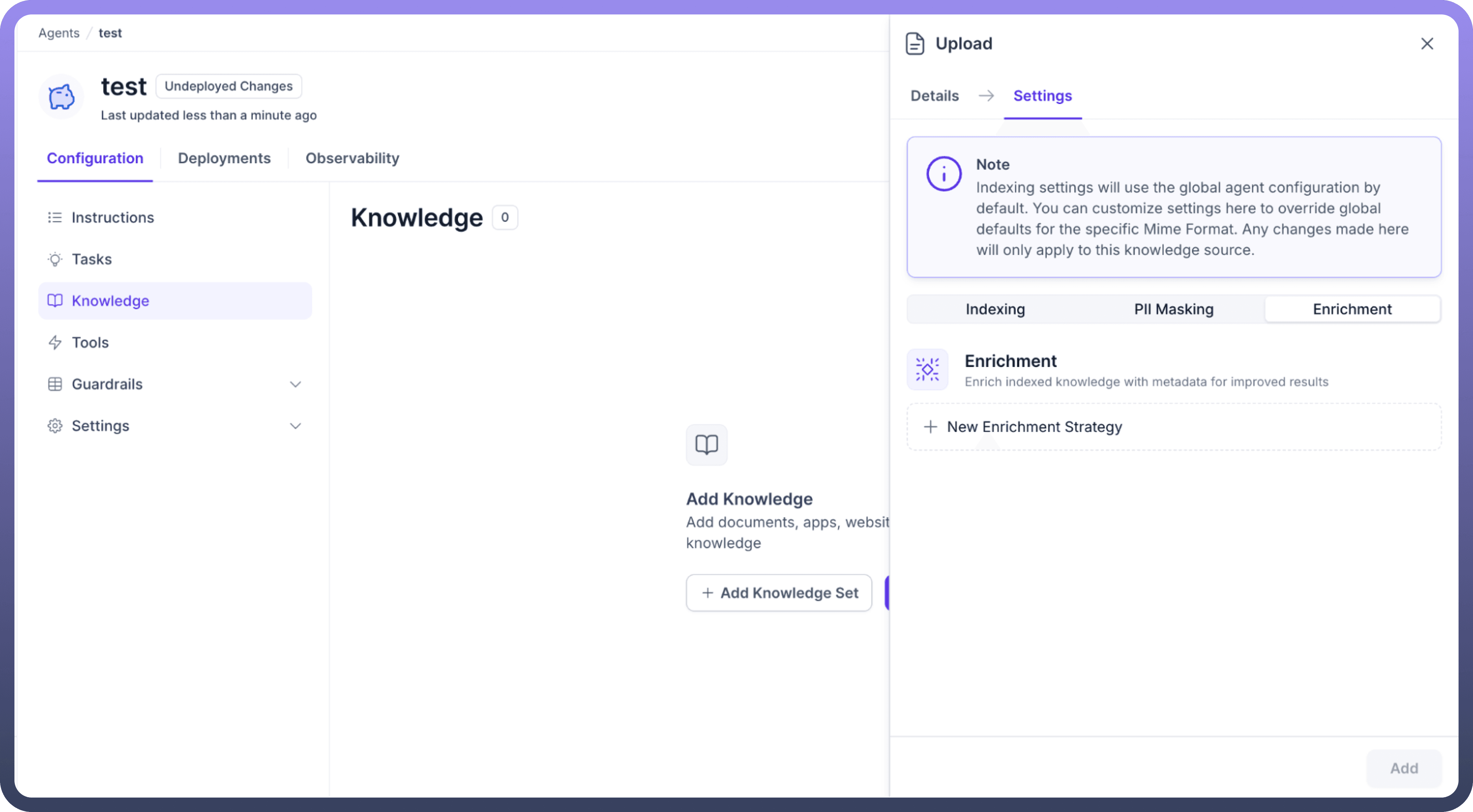
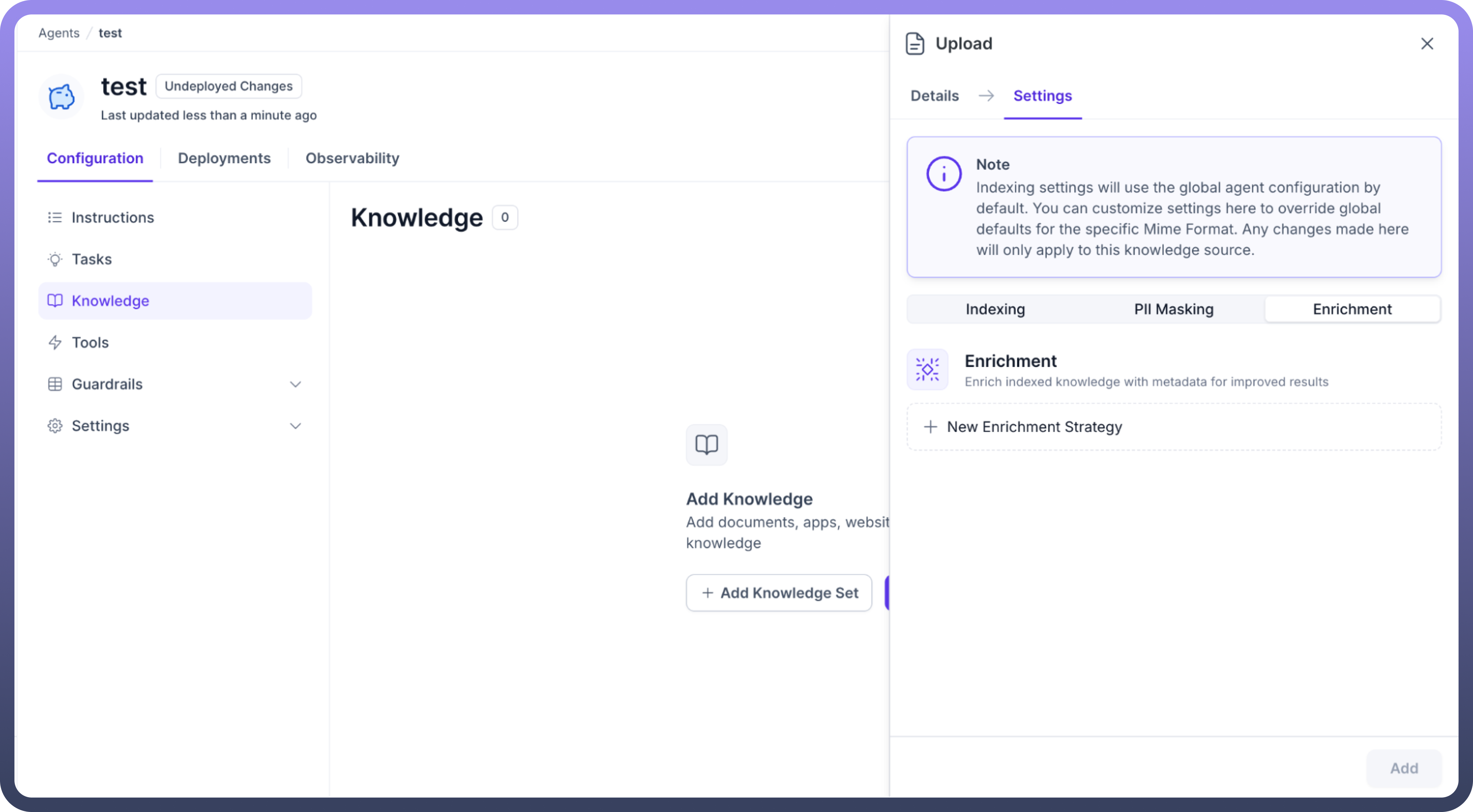
Creating New Enrichment Strategies
Processing Method: Choose the method to process and extract metadata from your content
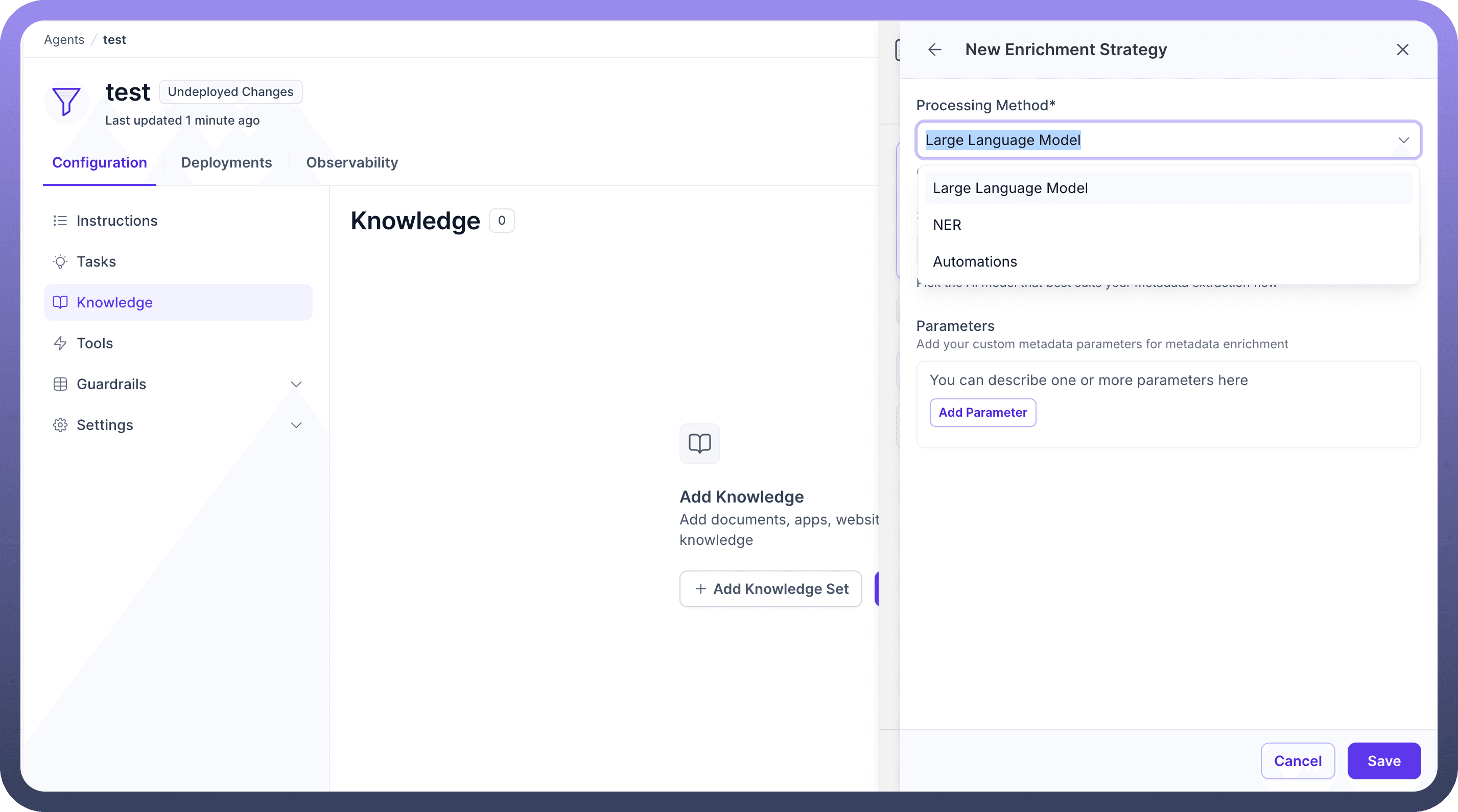
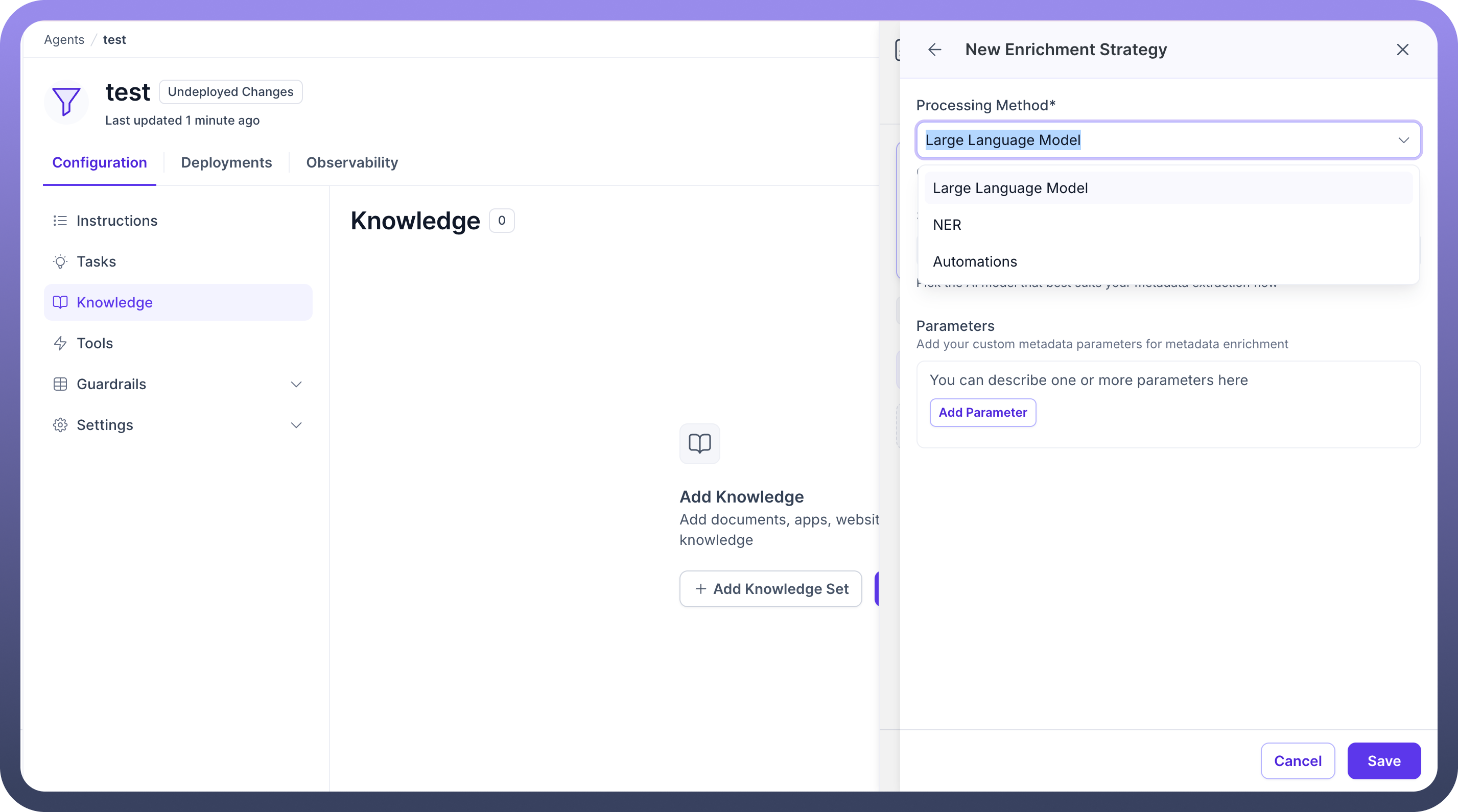
Automations: Select from existing automations or create new ones
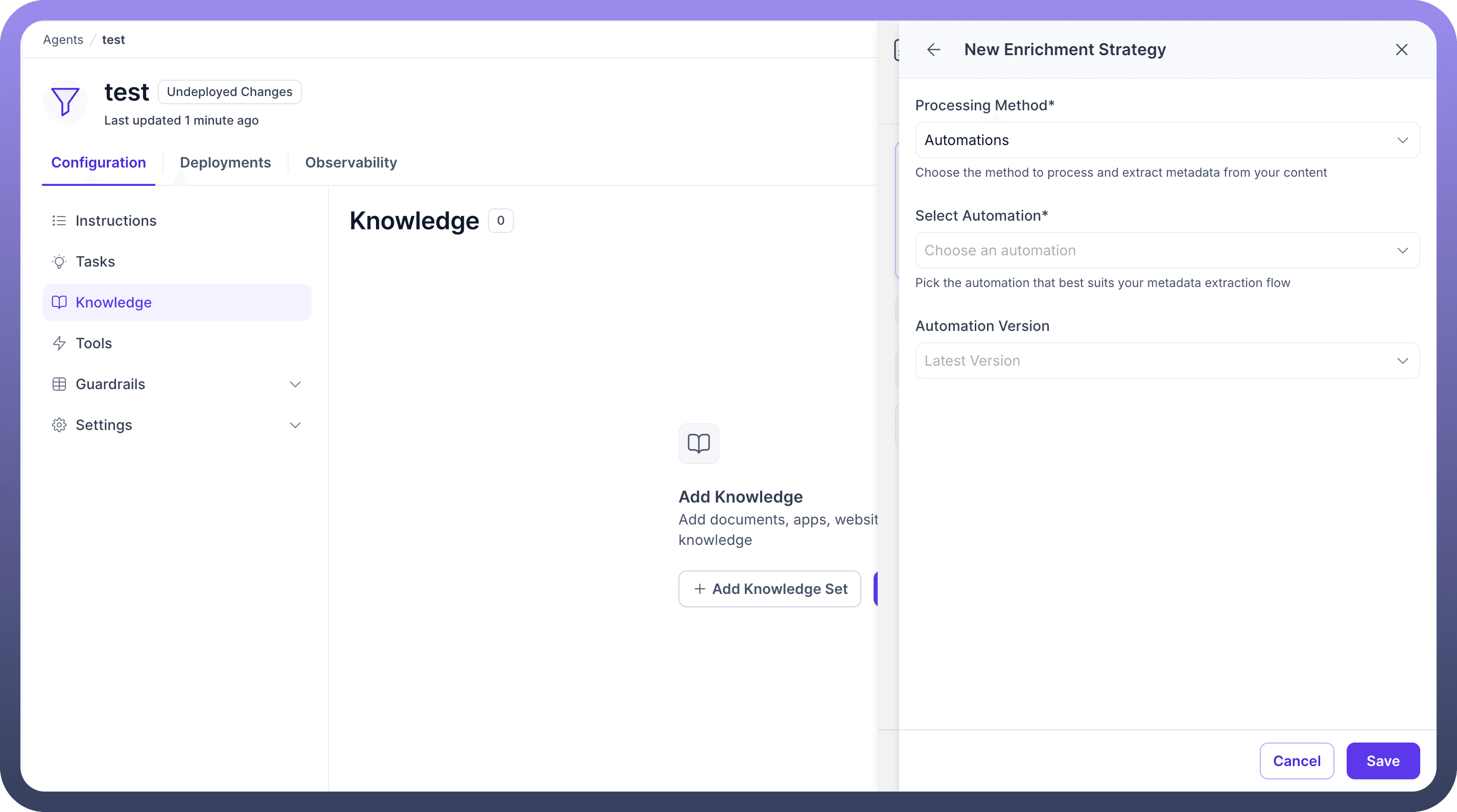
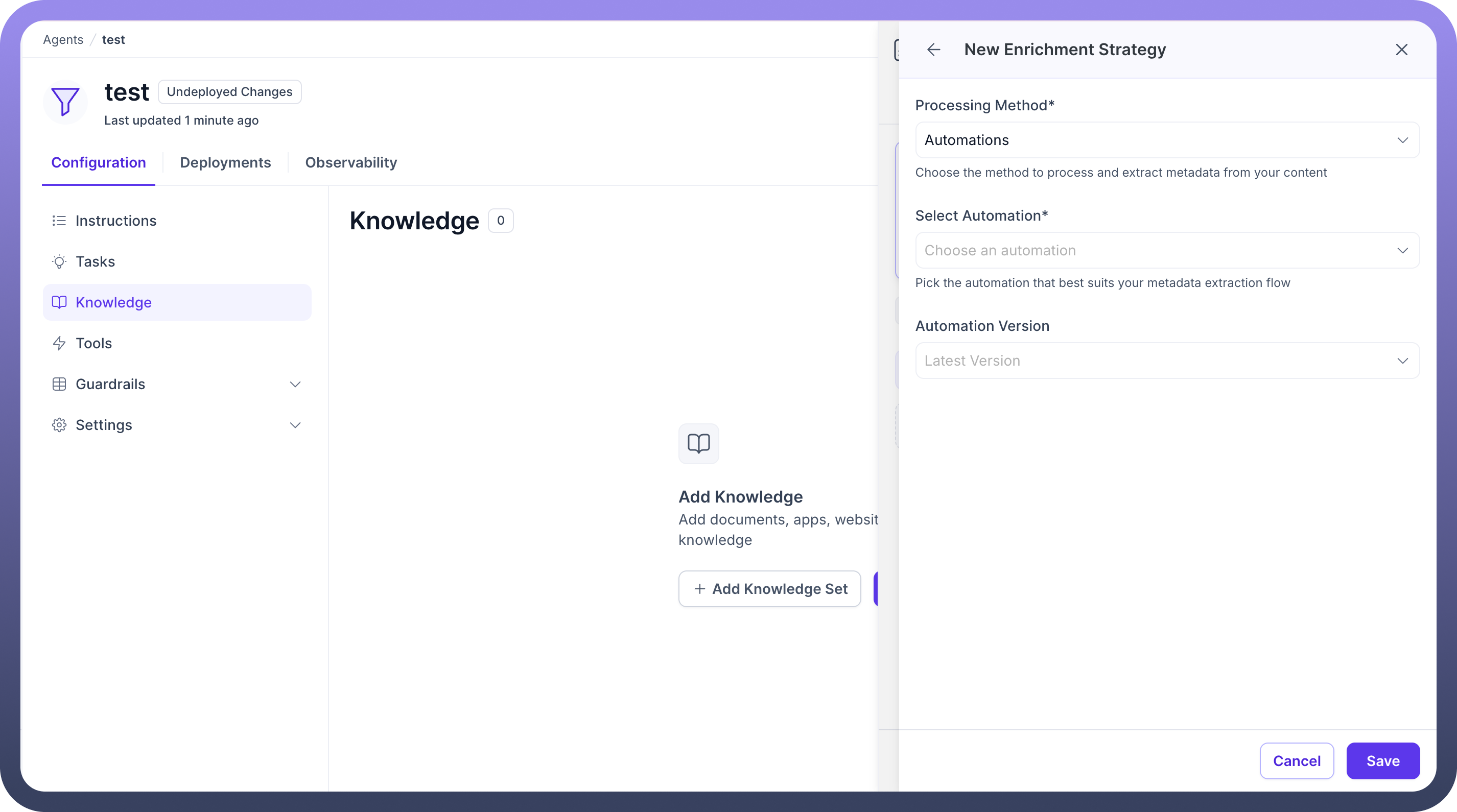
Large Language Model
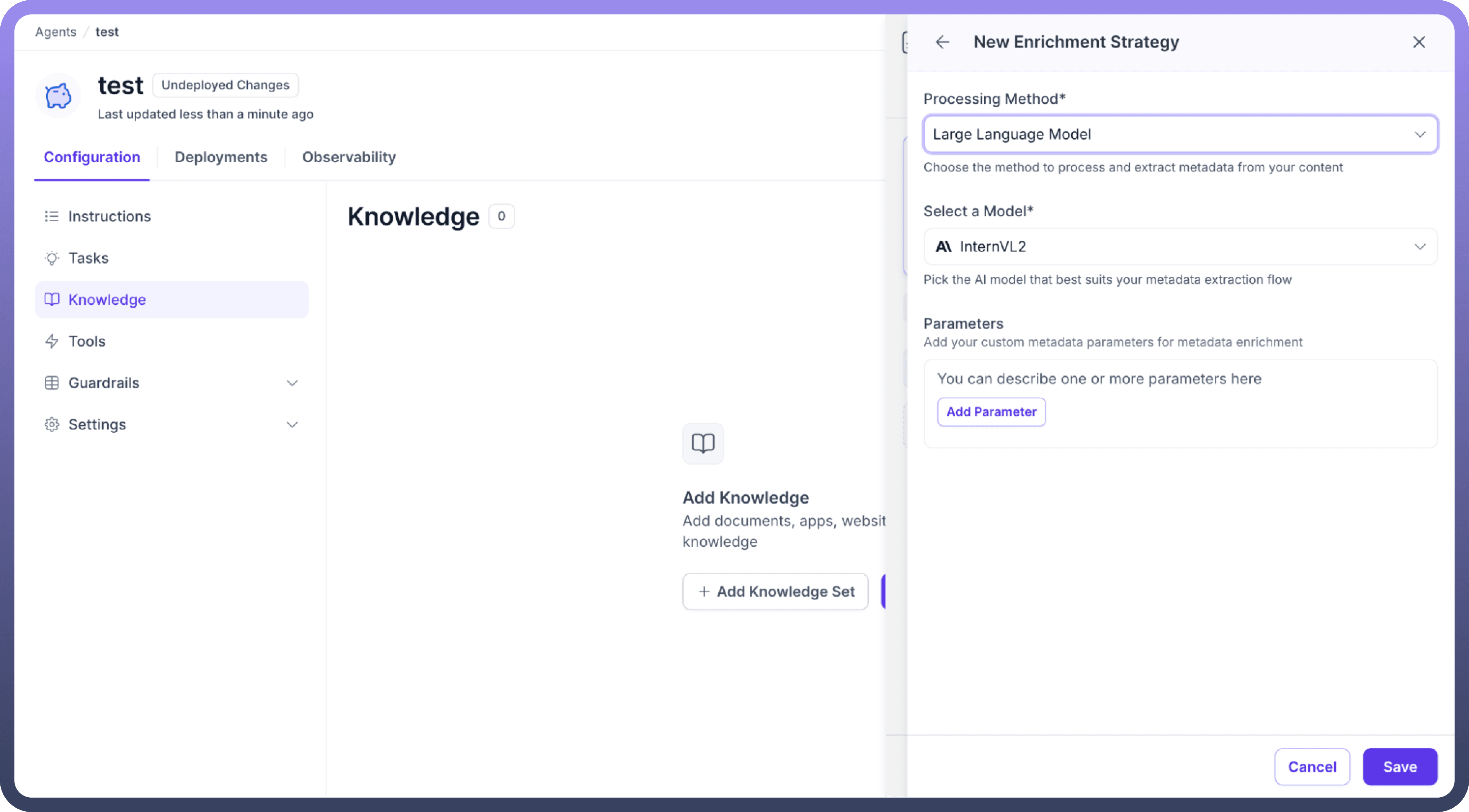
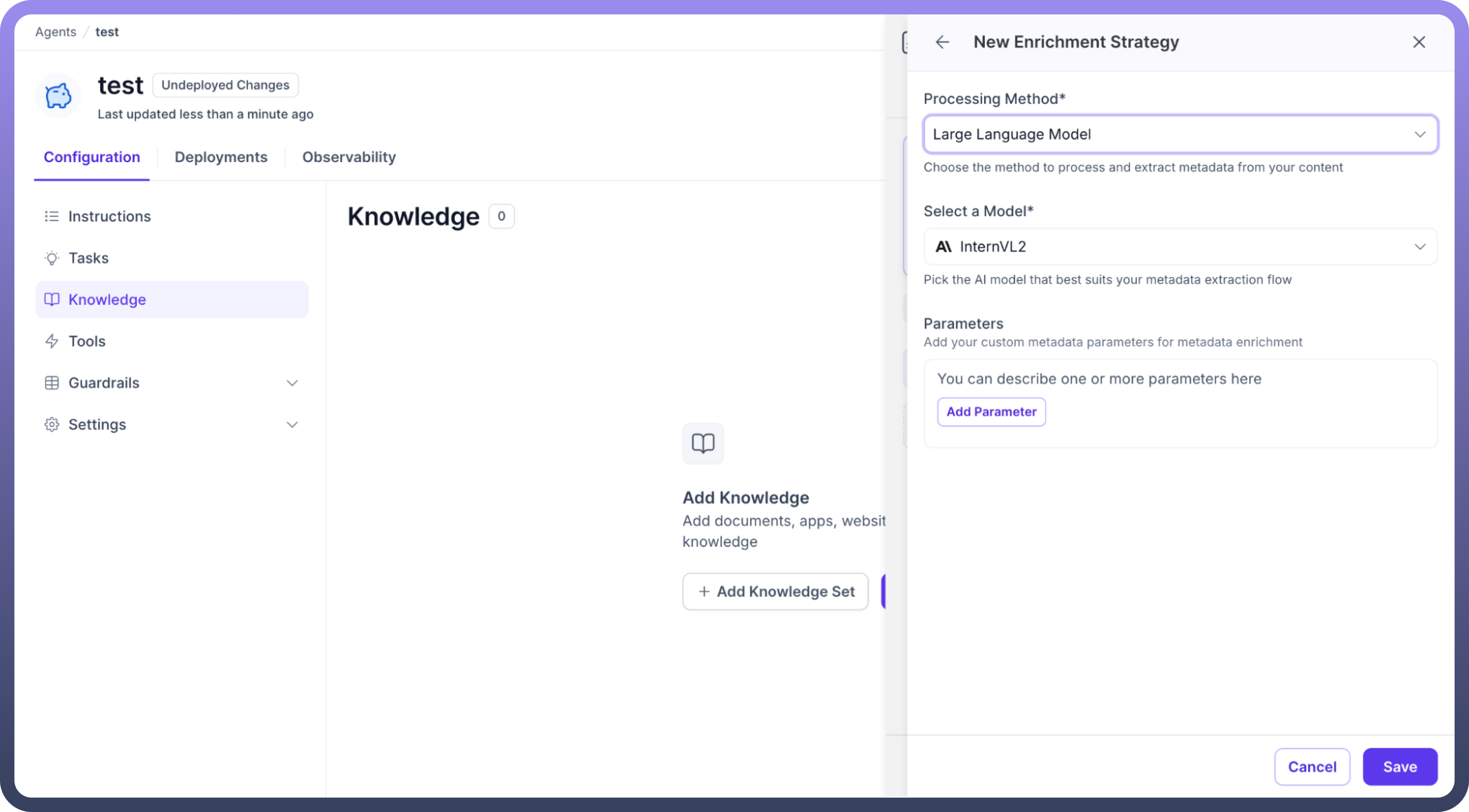
Model Selection: Select model that best suits your metadata extraction needs
Parameters Configuration:
Custom Metadata Parameters: Define specific metadata fields to extract
Multiple Parameters: Add multiple parameters for comprehensive enrichment
Knowledge Sets
Knowledge sets provide a single source of truth for multiple agents sharing the same knowledge base, eliminating the need to manage knowledge across individual agents.
Problem Solved
Without Knowledge Sets:
Must add knowledge to each agent individually
Updates require modifying every agent separately
Maintenance complexity increases with agent count
Inconsistency risks across agents
With Knowledge Sets:
Create centralized knowledge repository
Multiple agents reference the same knowledge set
Single update propagates to all connected agents
Consistent knowledge across all agents
Implementation Process
Navigate to Knowledge section
Click "
Add Knowledge Set"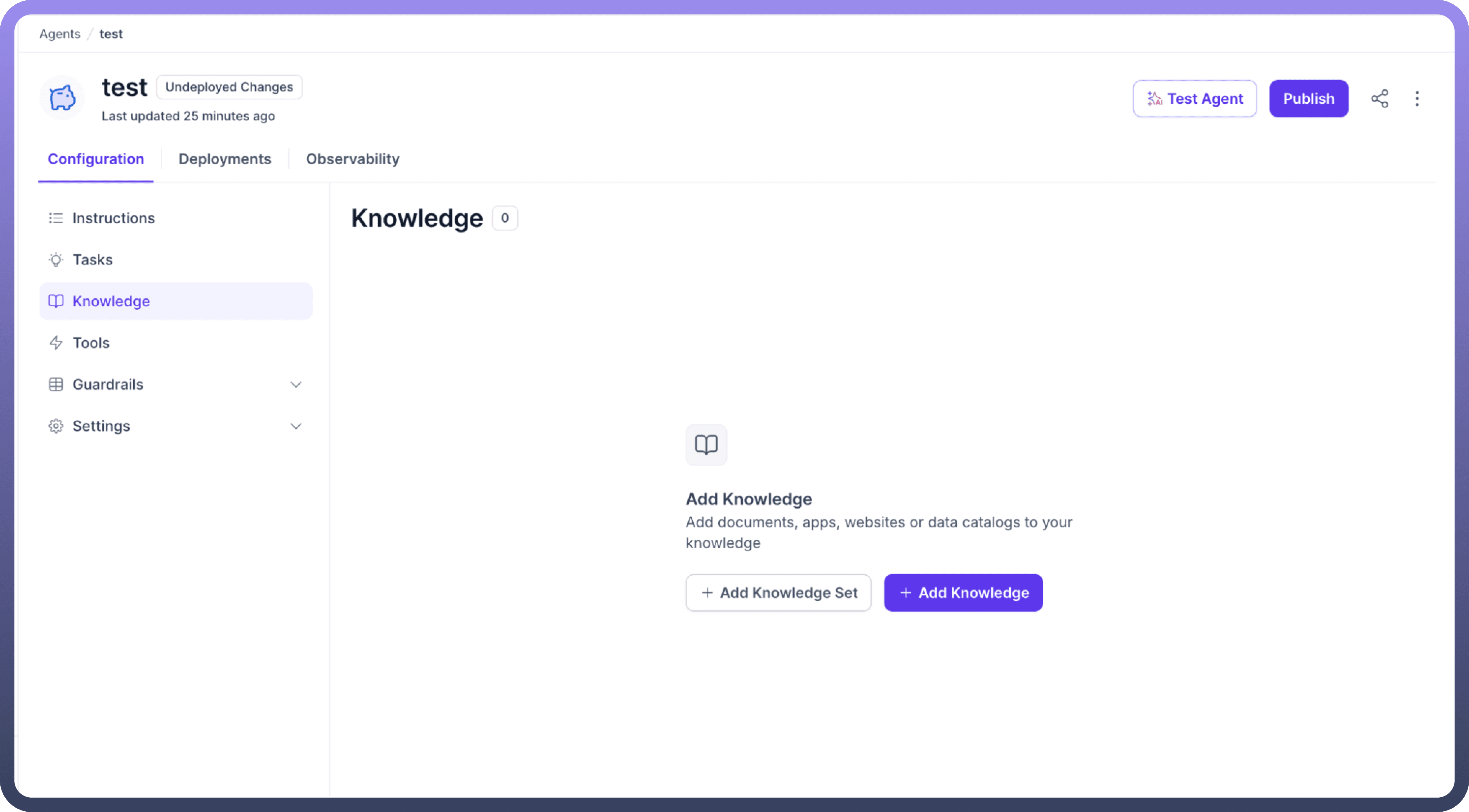
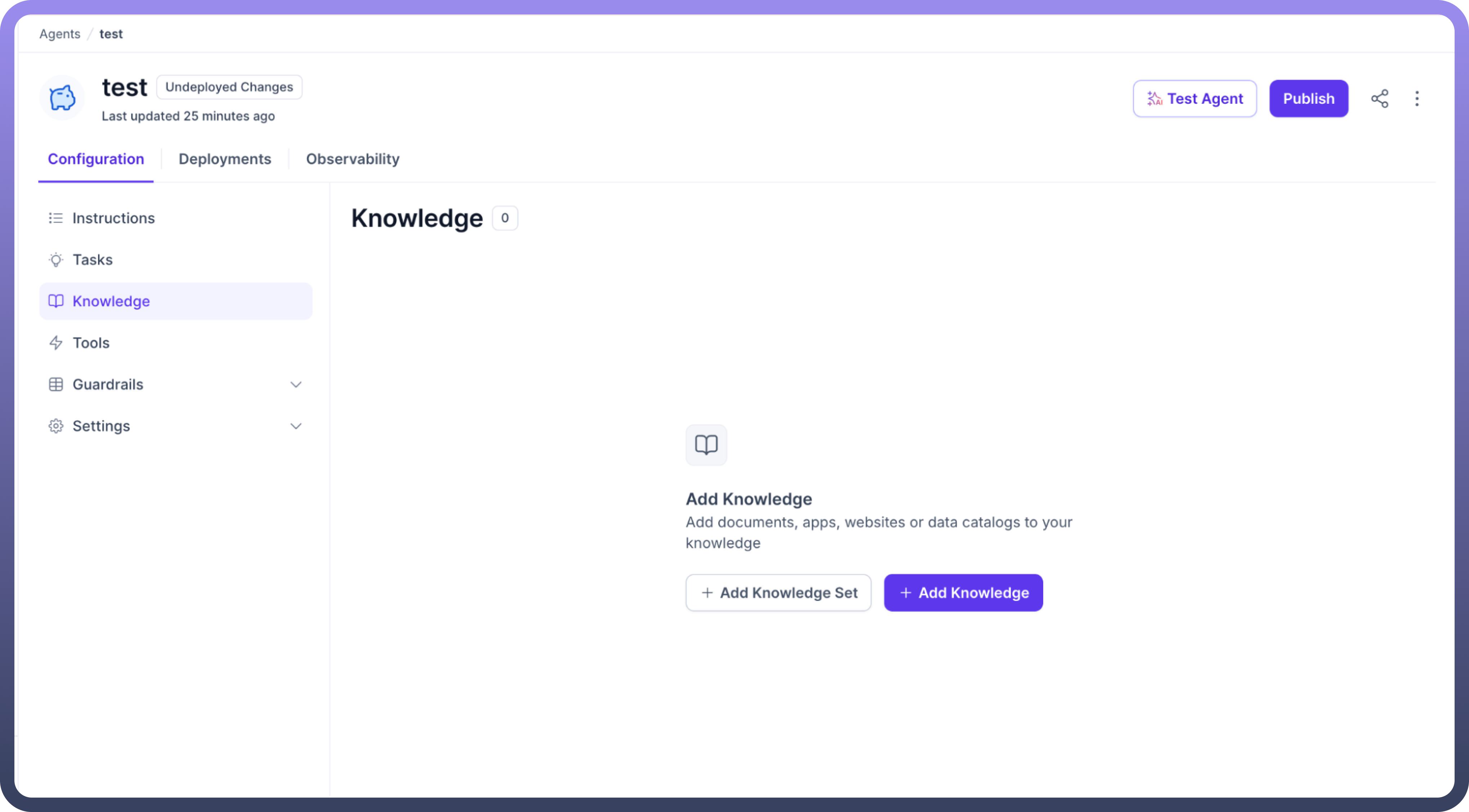
Create new knowledge set with descriptive name
Add knowledge documents using same configuration options
Reference knowledge set in multiple agents
Manage updates centrally through the knowledge set
Best Practices
Parsing Strategy Selection
Use Application-based for:
Simple text documents
Standard formatted files
High-volume processing needs
Performance-critical applications
Use Agentic-based for:
Documents with complex visual elements
Charts, graphs, and diagrams
Scanned documents requiring OCR
High-accuracy requirements
Chunking Optimization
Adjust chunk size based on content type:
Smaller chunks (256-512) for precise retrieval
Larger chunks (1024+) for context preservation
Configure overlap to maintain context between chunks
Enable summarization for lengthy content sections
PII Protection Strategy
Layer multiple methods:
Start with automatic PII detection
Add regex patterns for specific organizational data
Use automations for complex scenarios
Test thoroughly before production deployment
Regular audits of PII detection effectiveness
Enrichment Implementation
Start simple with basic metadata extraction
Gradually add complexity based on retrieval performance
Monitor enrichment impact on query results
Balance processing cost with retrieval improvement
Knowledge Set Management
Use descriptive names for knowledge sets
Group related knowledge logically
Monitor agent dependencies before making changes
Implement change management processes for updates
Troubleshooting
Common Issues
Parsing Failures:
Check file format compatibility
Verify connection configurations
Review document structure and quality
Consider switching parsing methods
Chunking Problems:
Adjust chunk size for content type
Modify overlap settings
Review chunking algorithm selection
Check for content formatting issues
PII Detection Issues:
Test regex patterns independently
Verify auto-detection coverage
Review automation logic
Check for false positives/negatives
Enrichment Failures:
Validate model selection
Review parameter definitions
Check automation workflows
Monitor processing performance
The knowledge settings system provides comprehensive control over how AI agents process, understand, and retrieve information. By carefully configuring indexing strategies, implementing appropriate PII protection, and leveraging enrichment capabilities, you can create highly effective and secure knowledge management systems. Knowledge sets enable scalable deployment across multiple agents while maintaining centralized control and consistency.
Success depends on understanding your specific use cases, testing configurations thoroughly, and iteratively optimizing based on performance metrics and user feedback.
